#critical role Champaign 3
Text
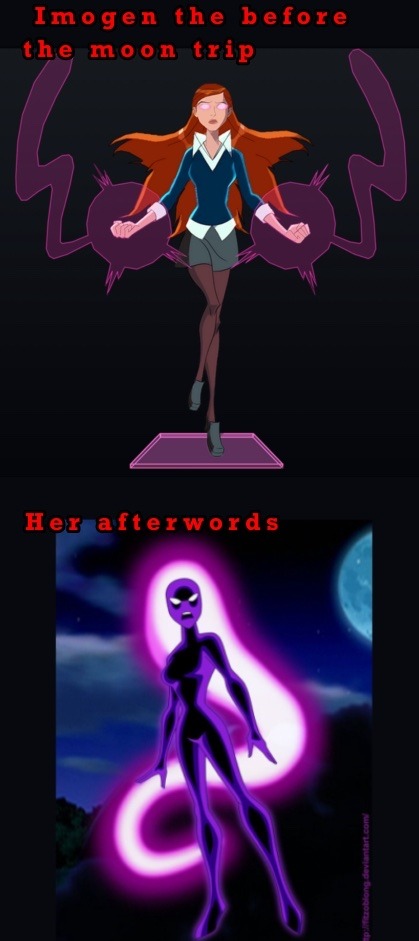
I’ve got a feeling it’s going to go this way,
What you all think?
#critical role#bells hells#fandom critical#imogen temult#red moon#critical role champaign 3#ruidus#reilora#ruidusborn#gwen tennyson#ben 10 alien force#Ben 10
36 notes
·
View notes
Text
The Lucian fight 🤝 The Otohan fight
putting the fear of GOD into the players/audience
#Critical Role#critical role champaign 3#ciritical role spoliers#fearne calloway#ashton greymoore#imogen temult#cr laudna#fresh cut grass#chetney pock o'pea#orym of the air ashari#otohan thull
43 notes
·
View notes
Text
TRAVIS IS PLAYING A OLD MAN AN DI DONT REMEMBER THIER NAME
2 notes
·
View notes
Text
15 Smart Ways to Avoid Getting Sick When You Travel
Assume getting ill while you journey is inevitable? Think once more.

Extra than 2.5 million passengers board a plane within the united states alone each and each day. And whilst many are looking forward to sitting on a beach somewhere getting a sun-kissed glow, limitless others will experience a much less-exceptional holiday side impact: getting unwell.
Among recycled air, questionable food, and jet lag, vacationers regularly locate that their immune systems are down for the remember, making their trip depressing within the manner. And while hand-washing can assist restriction a number of the germs you stumble upon on your travels, there's only a lot a sink and some soap can do. However, just due to the fact you've got continued sidelining tour illness before would not imply you need to once more.
We've got rounded up 28 clever ways to avoid getting unwell while you travel. So examine on, and live happier and more healthy in your subsequent adventure.
1-Sanitize Surfaces—Starting on the Plane

At the same time as cleaning crews do their first-class to preserve the plane easily, they can't tackle each germ. If you need to avoid getting ill from the germs left at the back of by means of different passengers, there is an easy answer: sanitize.
"while journeying, your palms turn out to be 'fomites,' which can be gadgets that switch germs picked up from touching surfaces," says dermatologist Cynthia Bailey, m.D., founder of dr. Bailey pores and skincare. Her concept? "travel with hand sanitizer wipes! Constantly wipe down the arms, far-flung, seat belt clip, and all tough buttons or systems you contact in your seat. Then discard the wipe. Use a brand new one for your palms." and while you want to live secure at some stage in your travels
2-Stay Hydrated on the Plane

That stale airplane air can quickly depart someone feeling dehydrated and commonly worse for put on. Fortuitously, consuming the proper ingredients can help fight this very quickly.
"I advocate ingesting mild and water-crammed foods, inclusive of a small salad and a chunk of fruit, and drinking lots of water on the aircraft because the air humidity is lots lower than our normal surroundings and it is so clean to end up dehydrated," says Dr. Tara Nayak, nd, a Philadelphia-based naturopathic doctor. And in case you need to hydrate extra healthily, high-tail it to one of the 25 US Towns with the fine ingesting water.
3-Get Your Shots

Earlier than you even e book your journey, ensure you are up to date on your shots. If you're visiting to a place where you're at danger for selecting up an illness like malaria, you is probably prescribed preventative medicine, as properly. "humans should use the cdc internet site for advocated vaccines with travel or see a travel health facility," recommends dr. Christina bowen, a board-certified integrative own family medication medical doctor.
4-Avoid Ice

In case you're going to a place wherein you have the motive to be concerned approximately the water quality, ensure to order your liquids with out ice. Even after freezing, tons of the micro organism and different contaminants inside the water, along with lead, will nonetheless remain. "do no longer order ice if the water's in question," says Dr. Bowen. "and most effective drink bottled drinks."
5-Get Up Periodically Throughout Your Flight

In case you're in for a protracted flight before you reach your vacation spot, ensure you get up periodically to stretch your legs.
"it's far critical to break up long plane rides or long vehicle rides via getting up often to move round and stretch. This could assist decrease your danger of blood clots. It could also save you again from aching after you have been slouching for hours within the equal role in a tiny seat," says Dr. Jasmine Marcus, DPT.
6-Load Up On the Right Vitamins
Want to reduce your risk of getting sick even before you touch down? The right supplements can help. "I always take a bit of vitamin A and vitamin D before boarding a plane to improve my immune function," says Dr. Nayak.
7-Add Some Probiotics to Your Routine

While you can't always control the number of illness-causing bacteria in your environment while you travel, you can control how your body responds. "While on vacation, I always up my dose of probiotics to make my body less friendly to invading bacteria!" says Dr. Nayak.
8-Skip the Booze on Your Flight

While having a cocktail to ease the stress of your flight may seem appealing, if you want to avoid getting sick, it's best to abstain. "I advise strongly against drinking alcohol while aboard a plane! I know it's tempting to get your vacation started but it only contributes to dehydration," says Dr. Nayak. Worse yet, alcohol can contribute to jet lag, leaving you sleep-deprived and at greater risk for illness.
9-Get Plenty of Sleep
While it may be tempting to stay up and explore, getting a good night's rest when you arrive at your destination will reduce your likelihood of getting sick in the long run. Researchers at the University of Washington have discovered a link between sleep deprivation and a suppressed immune system, so make sure to catch those Zs whenever you can.

10-Stick to Your Exercise Routine

Suppose you can skimp on exercising simply due to the fact you are on excursion? Assume once more. Researchers at the college of illinois, urbana-champaign have located that exercising can lessen the chance of developing breathing tract infections and shorten their duration, so ensure you're not skipping the gym.
11-Bring Mosquito Netting
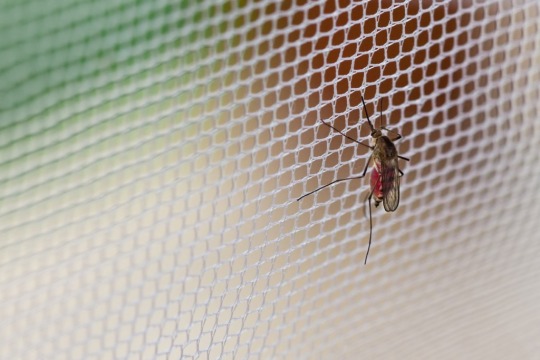
If you're traveling to an area with a high risk of mosquito-borne illness, make sure you pack mosquito netting, recommends Dr. Bowen. Not only will this help you reduce your risk of these potentially-deadly illnesses, knowing you have an extra layer of protection may also improve your sleep.
12-Load Up on Vitamin C-Rich Foods
The proper snack can make all the difference in how wholesome you are—and stay—while journeying. Flip to nutrition c-wealthy foods, like citrus fruit and bell peppers, to maintain that immune machine going robust. Researchers at the University of Otago in Christchurch, New Zealand have located that nutrition c now not simplest boosts immune function, assisting folks who load up on it lessen their threat of turning into unwell but also enables shorten the period of positive breathing ailments.

13-Cover Up
Preserving your pores and skin covered while you're on a journey permits you to avoid serious sunburns that could in any other case sideline you. "put on defensive apparel, like long sleeves and pants which have a breathable cloth, in hot regions," suggests Dr. Bowen.
14-Increase Your Fiber Intake

One clean way to hold yourself healthy while you journey? "get masses of fiber!" says dr. Nayak. "I suggest eating as plenty of clean fruit and vegetables as you may even as on holiday unless you are involved approximately infection! A breakfast of clean fruit with a chunk of protein is first-rate as you may be imparting your body with diet c and other minerals and vitamins that useful resource immunity."
15-Stick to a Nutritious Diet

Maintaining good health while you travel starts somewhere surprising: your gut. "Proper nutrition with a focus on good gut health will help our immune systems," says Dr. Bowen. Fiber-rich foods, as well as ones rich in probiotics, like yogurt, pickles, and kimchi, will all help feed your healthy gut bacteria, boosting your immune system in the process.
“ Vacation is all about relaxing, but for many people, travel is a stressful experience in and of itself. Unfortunately, if you find yourself stressed out on your trip, you may be at greater risk for illness.“ so relax and enjoy your moment.
3 notes
·
View notes
Note
hey there any idea where to watch all of the murder on the orient express deleted scenes? :)
Hey there, anon! Thank you for your ask. There are 11 deleted scenes on the Murder on the Orient Express (2017) dvd. Some have been uploaded online via media outlets and some by fans. I’m including links to the uploads, and my own screencaps of the rest of the scenes:
- Hotel Check-in - Poirot arrives at the Tokatlian hotel in Istanbul. He’s telegrammed specific orders about his room reservation (10 bath towels, 10 bottles of mineral water, etc). The scene introduces his OCD. I did a gif set of it.
- Poirot Bedtime Rituals - We see Poirot’s slimming exercises routine and moustache grooming. He’s wearing a corset. Here’s a gif set. The only look we have at Poirot’s famous moustache kit. Ken Branagh talks about the kit here.
- Pierre Michel (the conductor) interview - The only suspect interrogation scene they cut. It’s a shame because Marwan Kenzari’s performance is touching, and the location they went with for the interview is visually interesting.
- Departure - A great shot of the Orient Express leaving the station. We see all the characters inside the traincars as they speed past the camera. Poirot is at the very end in the last car, looking pleased. This isn’t a CGI scene, it was shot in camera.
- The following tweet from a fan has a video of three deleted scenes:
1) The Mr Ratchett/Poirot sequence from the Arasta Bazaar/Alternate Opening scene, an alternate - and much longer - intro scene of several characters before they get to board the train. The widowed Mrs Hubbard is chatting up a bunch of local children, Pilar Estravados the missionary is talking to a jewelry seller, Miss Debenham is taking pictures on her camera and spots the Count and Countess Andrenyi.
In the movie we only see Ratchett and the Count and Countess Andrenyi at the cafe, but no Poirot, who got cut out. In the full deleted scene he’s got a bigger role, he sees the Count fighting the paps and is about to intervene (rising from his chair), when the Countess arrives and the fighting stops. Poirot sits down again. He’s eating a lot of food, and getting excited over famous desert, and like the clip in the tweet shows, Mr Ratchett is also ordering him a bottle of champaigne, but Poirot asks for a cup of hot chocolate instead, and toasts Mr Ratchett in thanks. Chefs making the chocolate for Poirot and closeups of Godiva chocolate do not appear in either the deleted scene or the theatrical cut. I giffed the Godiva sequence here.

2) Dreamscape - The full “Poirot vision”-like scene in b&w in which we get inside Poirot’s mind. It’s a sort of re-cap of the different clues Poirot’s gathered so far. He’s looking at all the suspects one by one, and there’s a cool group shot of them facing him. More on this scene below.
3) bits of the Poirot Bedtime Rituals scene I’ve already mentioned.
That’s all the scenes I’ve managed to find online, there might be more out there, the studio took down several clips. The ones left from the dvd are:
- Alternate Opening - B&w scene of Colonel Armstrong alone in a gloomy, darkened living room. He’s watching a projector clip of himself, his wife and daughter at play when they were all happy and carefree. Little Daisy is playing with her teddybear and dolly.

- Newsreel (Extended) - B&w reel of news footage and newspaper clippings about the Armstrong kidnapping case, “the story that shocked the world”. It serves as background info for the audience. Shots of the crime scene, the funeral, mother screaming on the floor, Daisy’s teddybear guarding a fresh grave.
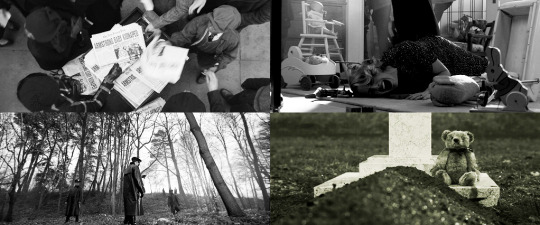
- Breakfast - The extra footage that was cut from the Wailing Wall scene. After Poirot exposes the Chief Inspector, the Inspector wants to attack him from behind but Poirot intercepts with his cane without looking back. He doesn’t see the breakfast boy with the eggs who’s followed him to the Wall, and he swings his cane, hitting theeggs by accident. The tops of the eggs the boy is holding out to him, are cut off. Next shot is of Poirot finally eating breakfast, he’s seated by the Wall, with the boy and a waiter standing beside him.

- Train Montage - A short clip of Orient Express staff/waiters setting the tables, bringing in crates of food, arranging champaigne bottles, etc. Just a few extra shots that didn’t make it into the film.

- Luggage - Bouc and Michel the conductor going through some of the passengers’ luggage. Mostly closeups of the contents of their suitcases, with quick shots of Estravados the missionary, Schmidt the maid, Marquez the salesman and Hardmanthe professor, and one extra line from Estravados.

There are about 30 mins of other deleted footage that never landed on the dvd, including two major action scenes - Poirot chasing MacQueen the assistant out in the blizzard, shooting at MacQueen in warning, then saving him from drowning when the man falls into a river, and Poirot defending himself from Dr Arbuthnot, almost falling off the train and using his wits to get back inside.
Changes from the original script to the theatrical cut: The original denouement scene happened in the dining car like in the book (and the 1974 movie), not outside, though I’m not sure if they ever filmed the first version. There are some huge differences between the original script and the film. A lot of the clue-explaining, some of the exposition, character-establishing and other character moments, extra lines from interrogation scenes, chunks of dialog, etc, were cut. Settings and certain lines of dialogue were changed. More canon quotes were added into the movie, such as Poirot’s famous “My name is Hercule Poirot and I’m probably the greatest detective in the world” line from The Mystery of the Blue Train. Miss Debeham and Dr Arbuthnot kissed twice in the original script! No kisses in the movie. Pilar Estravados was Greta Ohlsson, like in the book (Estravados’ name comes from Hercule Poirot’s Christmas). Poirot remembers his canon “love interest“ Vera Rossakoff. She only gets a mention but is kind of instrumental to him solving the case. Vera was changed into “Katherine” in the movie, a new character, someone from Poirot’s past. Was it because Vera might appear in future movies?
Most of the characters get a bit more screentime in the original script. Poirot has a HUGE, HUGE “getting-inside-the-detective’s-head” scene where he sees all the suspects frozen like ice, or like in a photograph, and he can walk through the photograph and observe each suspect, each frozen facial expression, and analyze what everyone told him in interviews. He’s looking at all the clues again in his mind, brushing away those that aren’t relevant. For the audience, this would have been a bigger and more helpful re-cap of the mystery compared to “Dreamscape” above. It would have been an amazing showstopper scene.
I wish they could have kept some of these scenes as one of the biggest criticisms about the movie was that the audience couldn’t really follow the clues and play “detective”, Poirot did all the explaining himself - and quickly - and didn’t give them enough of a chance to solve the mystery on their own. The screenwriter originally had POIROT ANALYZE ALL THE CLUES in great detail. All the clues from the book are present. Poirot’s all about the clues and observation. He brainstorms which suspect could be guilty, which pairs of suspects could have killed Ratchett together. He considers them all in his mind, all the variations and possibilities, and the audience can see his thoughts. He’s moving from one suspect to the next, in a “refresh my memory” sort of scene for the viewers.
He’s not “omnipotent” nor “guessing” like some critics have complained. He tells you how he came by the conclusions. He does it in the movie but originally he talked a lot, lot more, and the scenes were trimmed for time constraints. Some of the details regarding the clues were the first to go. I love the movie dearly and always will but there’s an even greater potential in the original script, I think. Hopefully we see more deleted footage on future dvd sets. :)
Thanks again for your ask! If anyone would like me to gif any of the deleted scenes, please let me know! :)
44 notes
·
View notes
Text
Did Robinhood Commit Breach Of Contract?
By Sylvia E, University of Illinois at Urbana-Champaign Class of 2024
February 16, 2021

The use of online forums to discuss stock trades and cryptocurrency has been common since the 1990s, but the advancement of communications technology increased the breadth of knowledge available to the layman, and subsequently, the ability of groups of people to engage in the stock market. The impact and potential of these online forums on market impact were brought into the spotlight in January 2021, when users on an online forum known as Reddit launched a movement to drive up the price of Gamestop stock using a strategy known as a “short-squeeze,” and succeeded, driving the previously dying stock up to astronomical prices[1].
Among the consequences of this short-squeeze were a series of class-action suits against Robinhood, an online brokerage company that allows investors to trade cryptocurrency and stocks. In response to the GME short squeeze, Robinhood decided to restrict the buying of GME stocks, only allowing investors to sell their stocks, but not purchase new ones. This sparked outcry from Robinhood customers, who have since filed a class-action suit against Robinhood.
A class-action suit is a type of lawsuit where a group of people who have experienced harm jointly file a lawsuit against a corporation or multiple corporations[2]. In this case, Robinhood customers who were deprived of the ability to buy GME stocks have filed a lawsuit against Robinhood. In this class-action suit, the plaintiff, or the group bringing forth the charge is alleging that “Robinhood purposefully, willfully, and knowingly removing the stock “GME” from its trading platform in the midst of an unprecedented stock rise thereby deprived retail investors of the ability to invest in the open-market and manipulating the open-market.”[3]
To prove this complaint, the plaintiff has proposed four causes of action, one of which is Breach of Contract. Breach of Contract argues that Robinhood violated their customer agreement and that this resulted in harm to the Robinhood customers. The main component of this cause of action states: “Robinhood breached its Customer Agreement by … failing to disclose that its platform was going to randomly pull a profitable stock from its platform; … failed to provide an adequate explanation to their customers… knowingly put their customers at a disadvantage … failed to provide access to its own financial incentives to pull certain securities including GME… prohibited plaintiffs from performing in a timely manner (or at all) under the contract;... failed to comply with all applicable legal, regulatory, and licensing requirements; and… failed to exercise trades and actions requested by customers” [3]
However, Robinhood’s Customer Agreement never guarantees the provision that they will disclose which stocks they will pull from their platform. In their customer contract, under “Customer Representations and Responsibilities Section F,” their customer agreement states: “I understand Robinhood may at any time, in its sole discretion and without prior notice to Me, prohibit or restrict My ability to trade securities.”[4] Since customers enter into an agreement prior to using services, it is expected that they are aware and will obey the terms of the contract. This clause means Robinhood had no obligation to inform their customers that they would be pulling Gamestop stocks.
Given the explicit statement in Robinhood’s customer agreement that they can prohibit or restrict the abilities of investors to trade stocks, it is unlikely that the plaintiff will win the case by pursuing Breach of Contract, a fact most legal experts agree with. After all, Robinhood is a brokerage company, and “there is no obligation that a broker-dealer has to unconditionally accept orders to buy, sell or short-sell securities.”[5] In addition, customer agreement language means the suit will most likely be dismissed before it makes it to the courtroom, further decreasing the plaintiff’s capacity to pursue relief for damages.[5]
Without substantive proof that the company (Robinhood) restricted trading for an improper reason, such as to favor certain investors [6], it is unlikely that the plaintiff will be able to successfully pursue their charges. Despite this, it is undeniable that the effects of the Gamestop short-squeeze have fundamentally changed the way Wall Street and the general public view stocks, and undeniable that Robinhood’s role in the short-squeeze will be increasingly scrutinized as the market endures further criticism from investors and the public.
______________________________________________________________
[1] Stewart, E. (2021, January 25). The GameStop stock FRENZY, EXPLAINED. Retrieved February 12, 2021, from https://www.vox.com/the-goods/22249458/gamestop-stock-wallstreetbets-reddit-citron
[2] Boeschen, C. (2019, September 13). How a class action lawsuit works. Retrieved February 12, 2021, from https://www.alllaw.com/articles/nolo/personal-injury/class-action-lawsuit.html
[3] United States District Court Southern District Of New York V. Robinhood Financial Llc Robinhood Securities, Llc Robinhood Markets, Inc., 21-cv-777, (2021). https://www.courtlistener.com/recap/gov.uscourts.nysd.553175/gov.uscourts.nysd.553175.1.0.pdf
[4] Disclosure library. (n.d.). Retrieved February 12, 2021, from https://robinhood.com/us/en/about/legal/
[5] Robinhood Users Suing Over Trade Limits Face High Legal Bar. (n.d.). Retrieved February 12, 2021, fromhttps://www.bloomberg.com/news/articles/2021-01-28/robinhood-customers-sue-over-removal-of-gamestop
[6] Hals, T. (2021, January 30). Analysis: Robinhood and Reddit protected from lawsuits by user agreement, Congress. Retrieved February 12, 2021, from https://www.reuters.com/article/us-retail-trading-robinhood-liability-an/analysis-robinhood-and-reddit-protected-from-lawsuits-by-user-agreement-congress-idUSKBN29Z0HI
0 notes
Text
Armenian Academics For Black Lives Matter
New Post has been published on https://armenia.in-the.news/politics/armenian-academics-for-black-lives-matter-28718-02-07-2020/
Armenian Academics For Black Lives Matter

A scene from a recent Black Lives Matter protest in Los Angeles, Calif. (Photo: Armen Adamian)
Three Armenian doctoral students from UCLA—Natalie Kamajian, Armen Adamian and Lilit Ghazaryan—penned the following statement to express solidarity for the Black Lives Matter movement. This initiative is intended to unite Armenian academics globally across various disciplines in their commitment to advancing anti-racist methodologies, perspectives and practices.
***
We, a group of Armenian academics, want to collectively express our support for the Black Lives Matter movement. As educators and knowledge producers, we cannot be neutral in the face of systemic oppression fueled by anti-Black racism in the United States and around the world. This is a call to all Armenian academics to actively dismantle white supremacist logics in both our personal and professional lives.
In understanding our own Armenian experience, we acknowledge that historical injustices are often reproduced in present hierarchies of power. We know that the Black experience is defined by perpetual injustice rooted in chattel slavery—specifically systematic marginalization, mass incarceration, manufactured poverty, and ultimately murder. Furthermore, the United States is a settler-colonial project founded on the genocide of Indigenous nations. This legacy of stolen land and stolen labor is a foundational element of the US capitalist enterprise. The Armenian past—rife with state-sanctioned oppression, genocide, dispossession, and exile—informs our position today. In recognizing these connections, it is our ethical obligation to challenge hegemonic systems of power in all of its forms.
At this critical juncture, we are reminded of the key role played by scholarship during social justice movements. We, as Armenian academics, promise to actively fight against structural anti-Black racism. We must interrogate our role in the reproduction of white supremacy. We must take issue with our direct or indirect investments in establishments that racialize, exploit, and impoverish communities. To do this, we call on our colleagues to decenter whiteness and eurocentrism in our pedagogies and curricula, and to make concerted efforts to engage the methodologies of Black radical thinkers. We also pledge to advocate for police divestment at our respective colleges and universities, and to help reimagine new strategies for public wellness and communal safety. Lastly, we will work towards building solidarity with other scholars of color (in particular Black and Indigenous) to advance meaningful allyship.
We, the undersigned, profess a vested interest in disentangling Armenianness from the mythology of whiteness. We promise that the knowledge we produce will be radically anti-racist and will side with those who are oppressed by harmful ideologies and repressive systems of power.
Natalie Kamajian, Ph.D. student, Culture and Performance, UCLA
Armen Adamian, Ph.D. student, Ethnomusicology, UCLA
Lilit Ghazaryan, Ph.D. student, Anthropology, UCLA
Signatories as of July 2, 2020
1. Melissa Bilal, Ph.D., Distinguished Research Fellow and Lecturer, Center for Near Eastern Studies and Department of Ethnomusicology, UCLA
2. Janice Okoomian, Assistant Professor of English/Gender and Women’s Studies, Rhode Island College
3. Shushan Avagyan, Assistant Professor, College of Humanities and Social Sciences, American University of Armenia
4. Tamar Shirinian, Postdoctoral Fellow, Department of Anthropology, University of Tennessee, Knoxville
5. Hourig Attarian, Associate Professor, College of Humanities and Social Sciences, American University of Armenia
6. Karena Avedissian, Ph.D., Centre for Russian and East European Studies, University of Birmingham
7. Susan Pattie, Honorary Senior Research Associate at University College London and former Director of the Armenian Institute in London
8. Arto Vaun, Chair, English & Communications Program, & Director, Center for Creative Writing, American University of Armenia
9. Lerna Ekmekçioğlu, Associate Professor of History and Women and Gender Studies, MIT
10. Nelli Sargsyan, Associate Professor of Anthropology, Marlboro College, Vermont, USA
11. Hrayr Attarian MD, Professor of Neurology, Northwestern University Chicago, USA
12. Seta Kabranian-Melkonian, Assistant Professor, Department of Human Services, University of Alaska, Anchorage, USA
13. Markar Melkonian, Lecturer, Department of Philosophy, California State University, Northridge, USA
14. Elyse Semerdjian, Professor of History, Whitman College
15. Houri Berberian, Professor of History, University of California, Irvine
16. Sophia Armen, Ph.D. Student, Ethnic Studies, UC San Diego
17. Rosie Vartyter Aroush, Ph.D., Armenian Studies, Gender & Sexuality Research, UCLA
18. Sebouh David Aslanian, Professor of History, Richard Hovannisian Chair of Modern Armenian History, and inaugural Director of Armenian Studies Center, Promise Armenian Institute, UCLA
19. Khatchig Mouradian, Lecturer in the Department of Middle Eastern, South Asian, and African Studies, Columbia University
20. Sylvia Angelique Alajaji, Associate Professor of Music, Franklin & Marshall College
21. Talar Chahinian, Lecturer, Armenian Studies Program and Department of Comparative Literature, University of California, Irvine
22. Jesse Arlen, Ph.D. Candidate, Near Eastern Languages & Cultures, UCLA
23. Arpi Melikyan, Ph.D. student, Department of French and Francophone Studies, UCLA
24. Meline Mesropyan, Ph.D., Fellow researcher at Graduate School of International Cultural Studies, Tohoku University
25. Sona Tajiryan, Ph.D. Candidate, History Department, UCLA
26. Aram Ghoogasian, Ph.D. student, Department of Near Eastern Studies, Princeton University
27. Astghik Hovhannisyan, Ph.D., Visiting Researcher at International Research Center for Japanese Studies/ Senior lecturer at Russian-Armenian University
28. Jennifer Manoukian, Ph.D. Candidate, Department of Near Eastern Languages and Cultures, UCLA
29. Gabriella Djerrahian, Ph.D., Assistant Professor, Department of Sociology and Anthropology, Concordia University
30. Nora Lessersohn, Ph.D. Candidate, Department of History, University College London
31. Carina Karapetian Giorgi, Ph.D., Department Chair of Social and Behavioral Sciences and Sociology Faculty at Antelope Valley College
32. Christian Garbis, Lecturer, College of Humanities and Social Sciences, American University of Armenia
33. Yevgenya Jenny Paturyan, Associate Professor, Political Science and International Affairs, American University of Armenia
34. Hrag Papazian, Adjunct Lecturer, College of Humanities and Social Sciences, American University of Armenia
35. Tsolin Nalbantian, University Lecturer, Department of Middle Eastern Studies, Leiden University
36. Rafik Santrosyan, Ph.D. in Linguistics, Adjunct Lecturer at the College of the Humanities and Social Sciences, American University of Armenia
37. Aram Kerovpyan, Ph.D., “Akn” Center for Modal Chant Studies, Paris
38. Anna Aleksanyan, Ph.D. Candidate, Strassler Center for Holocaust and Genocide Studies, Clark University
39. Vahram Elagöz, Ph.D., Adjunct faculty, Acopian Center for the Environment, American University of Armenia
40. Nora Tataryan, Ph.D., Adjunct faculty, Cultural Studies, Sabanci University, Istanbul
41. Sevan Injejikian, Ph.D. Candidate, University College London (UCL), Adjunct Faculty, American University of Armenia (AUA)
42. Deanna Cachoian-Schanz, Ph.D. student, Comparative Literature, University of Pennsylvania
43. David Kazanjian, Professor, University of Pennsylvania
44. Karen Jallatyan, Manoogian Post-doctoral Fellow and Lecturer, University of Michigan, Ann Arbor
45. Joanne Nucho, Assistant Professor, Pomona College
46. Suzie Abajian, Ph.D., SPUSD School Board Member, Orange County Department of Education Administrator, former adjunct faculty at LMU and Occidental College
47. Veronika Zablotsky, Mellow-Sawyer Postdoctoral Fellow, UCLA Luskin Institute on Inequality and Democracy, University of California, Los Angeles
48. Dzovinar Derderian, Ph.D., University of Michigan
49. Richard Antaramian, Assistant Professor of History, University of Southern California
50. Ararat Sekeryan, Ph.D. student, Slavic Languages & Comparative Literature, Columbia University
51. Michael Pifer, Ph.D., Lecturer, University of Michigan
52. Marianna Hovhannisyan, Ph.D. Candidate, Department of Visual Arts, University of California, San Diego
53. Helen Makhdoumian, Ph.D. Candidate, Department of English, University of Illinois, Urbana-Champaign
54. Movses Pogossian, Professor of Violin, Director, UCLA Armenian Music Program, Herb Alpert School of Music, University of California, Los Angeles
55. Lori Khatchadourian, Associate Professor, Department of Near Eastern Studies, Cornell University
56. Kim Hekimian, Ph.D., Assistant Professor of Nutrition in Pediatrics, Columbia University Vagelos College of Physicians and Surgeons
57. Sevan Beukian, Ph.D., Lecturer, Department of Political Science and Department of Women and Gender Studies, University of Alberta, Canada
58. Anahit Galstyan, Ph.D. student, Department of History of Art and Architecture, University of California, Santa Barbara
59. Ann R. Karagozian, Distinguished Professor of Mechanical and Aerospace Engineering and Inaugural Director, The Promise Armenian Institute, UCLA
60. Hayarpi Papikyan, Ph.D., Adjunct Faculty, American University of Armenia (AUA)
61. Alexandra Boghosian, Ph.D. student, Department of Earth and Environmental Sciences, Columbia University
62. Ayda Erbal, Lecturer, Department of Politics, New York University
63. Zoe Sherinian, Professor of Ethnomusicology, University of Oklahoma
64. Robin Garabedian, Ph.D. Candidate, Department of English, University of Massachusetts, Amherst
65. Rachel Goshgarian, Associate Professor of History, Lafayette College
66. Anahit Manoukian, Ph.D. student, Department of Spanish and Portuguese, UC Berkeley
67. Margaret Sarkissian, Professor of Ethnomusicology, Smith College
68. Aram Goudsouzian, Professor of History, University of Memphis
69. Alique Berberian, Ph.D. student, Department of Environmental Health Sciences, Fielding School of Public Health, UCLA
70. Arin A. Balalian, DrPH student, Department of Epidemiology, Mailman School of Public Health, Columbia University
71. Laure Astourian, Assistant Professor of French, Bentley University
72. Jolie Mandelbaum, Ph.D. Candidate, Department of English, University of Missouri
73. Bedross Der Matossian, Associate Professor of Modern Middle East History, University of Nebraska, Lincoln
74. Arpi Siyahian, Ph.D, University of Nebraska, Lincoln
75. Kristine Martirosyan-Olshansky, Ph.D., Postdoctoral Scholar, Cotsen Institute of Archaeology, University of California Los Angeles
76. Misak Khachatryan, Psy.D. Student, The Wright Institute
77. Elise Youssoufian, Ph.D. student, Philosophy and Religion, concentration in Women’s Spirituality, California Institute of Integral Studies
78. Marine Sargsyan, Ph.D. Candidate in Political Science, Roma Tre University, Italy
79. Armine Ishkanian, Associate Professor in Social Policy and Executive Director, Atlantic Fellows for Social and Economic Equity, International Inequalities Institute, London School of Economics, UK
80. Christopher Sheklian, Ph.D., Krikor and Clara Zohrab Information Center
81. Anna Nikoghosyan, Lecturer, Yerevan State University
82. Sossie Kasbarian, Senior Lecturer in Comparative Politics, University of Stirling, Scotland
83. Kohar Avakian, Ph.D. candidate, American Studies, Yale University
84. Lisa Gulesserian, Preceptor on Armenian Language and Culture, Harvard University
85. Victor Agadjanian, Professor, Department of Sociology and the International Institute, UCLA
86. Arlene Voski Avakian, Professor Emeritus, Department of Women. Gender, Sexuality, University of Massachusetts Amherst
87. Christina Mehranbod, Ph.D. Student, Department of Epidemiology, Mailman School of Public Health, Columbia University
88. Artyom H. Tonoyan, Research Associate, University of Minnesota, Twin Cities
89. Lilit Keshishyan, Ph.D., Lecturer, The Writing Program, University of Southern California
90. Shushan Karapetian, Ph.D., Deputy Director, Institute of Armenian Studies, University of Southern California
91. Lara Tcholakian, Ph.D. Candidate, Department of Management & Organization, Vrije Universiteit Amsterdam
92. Anahid Matossian, Ph.D. Candidate, Anthropology, University of Kentucky
93. Vazken Khatchig Davidian, Post-Doctoral Fellow, Oriental Institute, University of Oxford
94. Kevork Oskanian, Honorary Research Fellow, University of Birmingham
95. Kamee Abrahamian, Ph.D. Candidate in Depth Psychology at Pacifica Graduate Institute
96. Henry C. Theriault, Ph.D., President, International Association of Genocide Scholars, and Founding Co-Editor, Genocide Studies International
97. Marc Mamigonian, National Association for Armenian Studies and Research, Director of Academic Affairs
98. Naneh Apkarian, Assistant Professor of Mathematics Education, Arizona State University
99. Armen Karamanian, Ph.D., University of Technology Sydney
100. Kristin Cavoukian, Ph.D., Sessional Lecturer, Department of Political Science, University of Toronto Mississauga
101. Haig Armen, MDM, Associate Professor of Design, Emily Carr University of Art + Design, Vancouver, BC
102. Ara Sanjian, Associate Professor of History and Director of Armenian Research Center, University of Michigan, Dearborn
103. Hagop Gulludjian, Ph.D., Lecturer, Near Eastern Languages and Cultures, University of California, Los Angeles
104. Lalai Manjikian, Ph.D., Professor, Humanities Department, Vanier College, Montreal, Quebec
105. Serouj Aprahamian, Ph.D. Candidate in Dance Studies, York University
For those interested in signing the statement, please complete this Google Form with your information. The Google Document will be updated manually. To view the most updated version, please click here.

Guest Contributor
Guest contributions to the Armenian Weekly are informative articles written and submitted by members of the community, which make up our community bulletin board.

Latest posts by Guest Contributor (see all)
Read original article here.
0 notes
Text
Which method of coaching is the most productive in Sport?
In order to identify which coaching method is the most productive, in the first instance, I need to clarify if I am coaching for Participation or Performance Enhancement (Cross & Lyle, 2003). Participation coaching is where the objective is not competition success. An example of this is when I coach Bike Fix and Bike-ability. The emphasis is on taking part, not being the best in the class. On the contrary, Performance coaching involves longer-term goals and following the coaching process. For instance, my coaching role in Football involves both subjective and objective measurements (Franks, Goodman & Miller, 1983).
The coaching process is an on-going cycle of performance and practice (Franks, Goodman & Miller, 1983), within which a coach is required to evaluate, intervene, and feed-back information to athletes, with the goal of enhancing future performance (Carling, Williams & Reilly, 2005; Hughes and Bartlett, 2008).

Figure 1. Diagram adapted from Franks, Goodman & Miller (1983), representing the coaching process
Coaching intervention has traditionally been based on subjective observations of athletes (Hughes & Franks, 2004) however the analysis section is a critical component and impacts on the coaching process as a whole. Therefore, methods which enable the analysis to be more objective can only be positive due to the interpersonal relationship between athlete and coach (Franks, Goodman & Miller, 1983; Cross & Lyle, 2003). Lyle (2002) argues that improvements to coach education and to coaching practice depend on a sound understanding of the coaching process (Cushion, Armour & Jones, 2006).
In addition to the difference between Participation and Performance coaching, clarifying the subject content of the session is vital as children learn differently and in a variety of ways. Communication skills are important for a coach because when meeting children and teachers, at a new school for the first time, first impressions count (UK Coaching, 2018). A Directive Coaching method confirms this.
Bike Fix and Bike-ability are instructional led and are participation based sessions. Instructional strategies are a progressive way to challenge skills and are used by both coaches and peers to bolster an individual’s efficacy (Bandura, 1977). By asking a variety of open and closed questions, I can not only assess the current level of ability but also promote understanding of the topic being delivered and get to know the person I am coaching (Burkinshaw, 2020). I then use a guided discovery approach as it is an efficient method of making athlete’s motivated as they solve the problem through the use of the communication and team work skills.
Please take a look at the video below at a recent Bike Fix session.
https://drive.google.com/open?id=1GtoKWw3noGxSDXQueIx1a16XNXVU89jH
When coaching Football in Performance sessions, I often use a combination of problem-solving scenarios and guided discovery, to enable the players to work out the solution for themselves, regardless if they make a mistake or come to the wrong answer. Without failure or experience of these rocky roads, success will never be acquired (Collins, MacNamara & McCarthy, 2016). Coaches and players share a unique and important relationship (Miller, Franken and Kiefer, 2007).
The whole-part-whole method is an excellent resource to improve on passing and/or shooting accuracy (Soccer Drive, 2020). I find this vital for player’s to learn, retain and transfer this into a game scenario (Vera, Alvarez & Medina, 2008). Alternatively, games for learning can be put into practice to enhance both technical and tactical importance (Cope & Watts, 2000).
The video below demonstrates this.
https://drive.google.com/open?id=1BKrF2aK3ROW-rk3b14KqlGbdCDZaNg9G
In conclusion, I feel that by being able to employ a variety of coaching methods , using a holistic approach and reflect on their usefulness, enables me to become a better coach (Cushion, 2018). The ability of coaches being able to communicate their ideas to participants is vital and one that successful coaches must have (Lynch, 2001 & Frost, 2009). Therefore, an overemphasis on an episodic approach may hinder the development of coaching effectiveness (Cross & Ellice, 1997).
References
Bandura, A. (1977). Self-efficacy: Toward a unifying theory of behavioural change. Psychological Review, 84: P191–215
Burkinshaw , L (2020). We Must Understand the People We Coach.
Accessed 24/02/2020.
https://www.ukcoaching.org/resources/topics/expert-opinions/subscription/we-must-understand-the-people-we-coach
Carling, C; Williams, A; and Reilly, T. (2005). The Handbook of Soccer Match Analysis. London. Routledge.
Collins, D; MacNamara, A & McCarthy, N (2016). Putting bumps in the rocky road: optimising the pathway to excellence. Frontiers in Psychology.
Cope, J and Watts, G (2000). Learning by doing – An exploration of experience, critical incidents and reflection in entrepreneurial learning. International Journal of Entrepreneurial Behaviour and Research.
Accessed 20/03/2020
https://www.emerald.com/insight/content/doi/10.1108/13552550010346208/full/html
Cross, n and Ellice, C (1997). Coaching effectiveness and the coaching progress: field hockey revisited. Scottish Journal of Physical Education. 25 (3). P19-33.
Cross, N and Lyle, J (2003). The Coaching Process. Principles and Practice for Sport. London. Butterworth-Heinemann.
Cushion, C (2018). Reflection and reflective practice discourses in coaching: a critical analysis
Accessed 24/02/2020
https://www.tandfonline.com/doi/full/10.1080/13573322.2016.1142961?src=recsys
Cushion, C; Armour, K and Jones, R (2006). Locating the coaching process in practice: Models 'for' and 'of' coaching. Physical Education and Sport Pedagogy
Accessed 28/02/2020
https://www.researchgate.net/publication/233523508_Locating_the_coaching_process_in_practice_Models_'for'_and_'of'_coaching
Franks, I; Goodman, D and Miller, G (1983). Analysis of Performance. Qualitative or Quantitative. Sports. March.
Hughes, M, and Bartlett, R. (2008). What is performance analysis. The Essentials of Performance Analysis: An introduction. P8-20. London. Routledge.
Hughes, M and Franks, I (2004). Notational Analysis of Sport. Systems for better coaching and performance in sport. 2nd edition. Oxon. Routledge.
Lyle, J (2002). Sports Coaching Process: A framework for coaches’ behaviour. London. Routledge.
Lynch, J (2001). Creative Coaching. Champaign. IL. Human Kinetics.
Miller, M, Franken, N, and Kiefer, K (2007). Exploring Touch Communication Between Coaches and Athletes. Indo-Pacific Journal of Phenomenology. (Volume 7, edition 2).
Accessed 17/03/2020
https://www.tandfonline.com/doi/abs/10.1080/20797222.2007.11433953
Soccer Drive (2020). Whole-Part-Whole Practise Philosophy.
Accessed 20/03/2020
https://www.soccerdrive.com/blog/1/whole-part-whole-practice-philosophy
UK Coaching Research Team (2018) Communication and Coaching.
Accessed 15/03/2020
https://www.ukcoaching.org/resources/guides/communication-and-coaching
Vera, J; Alvarez, J and Medina, M (2008). Effects of Different Practice Conditions on Acquisition, Retention, and Transfer of Soccer Skills by 9-Year-Old Schoolchildren.
Accessed 18/03/2020
https://journals.sagepub.com/doi/abs/10.2466/pms.106.2.447-460
0 notes
Text
Ebertfest 2019: A Photo Journal
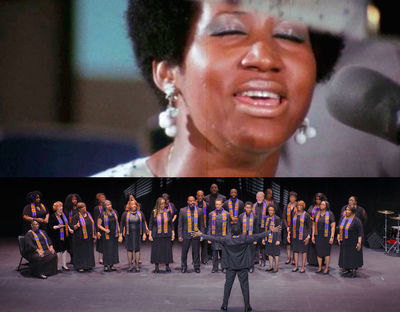
Roger's presence was alive and well in the Virginia Theatre at our 21st Ebertfest! Festival Director Nate Kohn and I presented the Roger Ebert's Film Festival in collaboration with Roger's alma mater, the College of Media at the University of Illinois at Urbana-Champaign. We were assisted by Festival Coordinator, Andrew Michael Hall ("Andy"). The following photo diary offers snapshots of our cherished memories that took place April 10th through April 13th in Champaign and Urbana, Illinois.
Photos courtesy of Timothy Hiatt.
DAY ONE
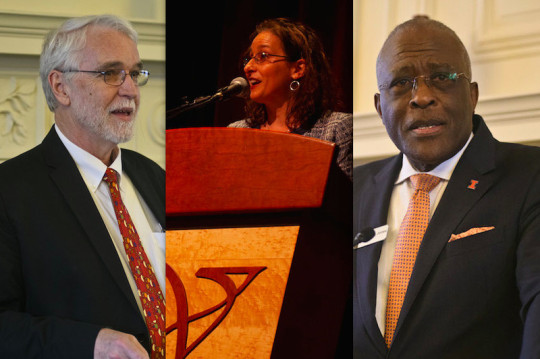
The Opening Night Gala for Ebertfest was hosted graciously by University President Timothy Kileen and his wife Dr. Roberta Johnson. Opening speeches were also given by Chancellor Robert Jones and College of Media Dean Tracy Sulkin.
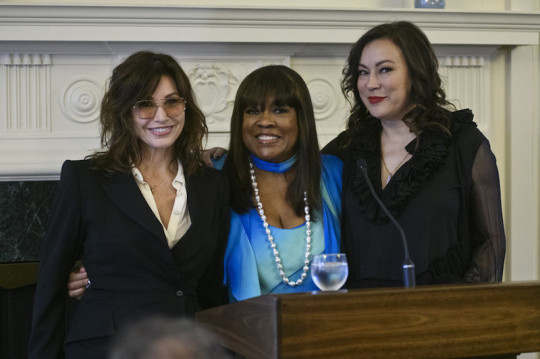
During my speech at the gala, I was joined at the podium by two of the festival's special guests, Gina Gershon and Jennifer Tilly. Coincidentally, Gina Gerson's cousin, Alan Elliott, preserved, restored and presented our opening night selection, "Amazing Grace," the amazing documentary about Aretha Franklin recording the best selling gospel album in history over two nights in a church in Watts, Los Angeles in 1972.

Preceding "Amazing Grace," Alan Elliott was joined onstage for a Q&A with producer Tirrell D. Whittley and our Ebert Fellow, Whitney Spencer. Elliott told us of his musical roots and of how he was influenced by gospel music and why he was so passionate about bringing this performance of Aretha Franklin to the public.
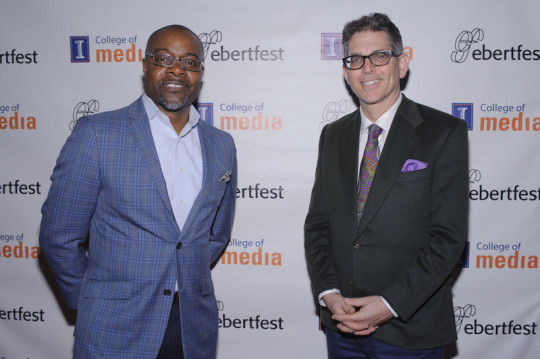
Tirrell Whittley's background as a Deacon was evident in his powerful invocation. Once we saw this powerful film we understood Alan Elliott's quest to bring it to the screen. It is being distributed by NEON and has opened in select theaters across the country. No doubt church groups and many others will line up to see this historic performance.

The crowd-pleasing screening concluded with a performance by the Martin Luther King Jr. Community Choir of Champaign-Urbana that had the audience on its feet.
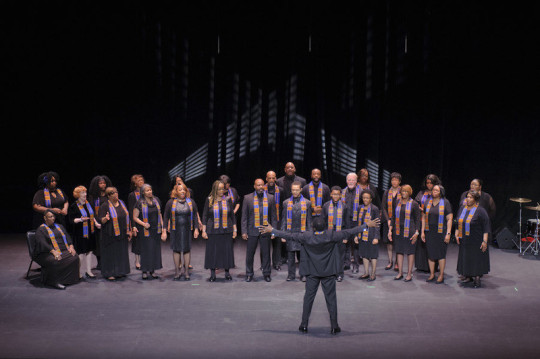
Turns out moving our musical finale of the festival to opening night was a great idea after all. It raised our spirits through the roof and held them there through the entirety of the week.
DAY TWO
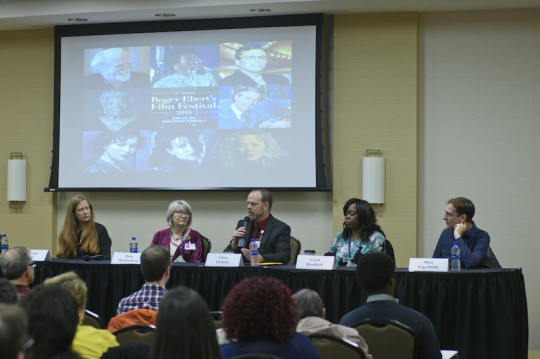
Prior to showtime at the Virginia Theatre, two inspiring academic panel discussions were held at the nearby Hyatt Hotel, the first sponsored by the Champaign County Alliance for Inclusion and Respect.
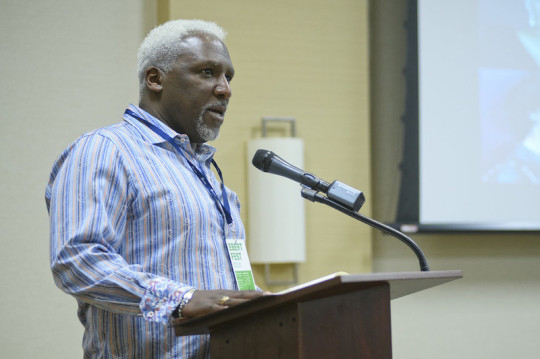
It was entitled "Challenging Stigma Through the Arts," and moderated by Dr. Eric Pierson. The discussion challenged whether the images of addiction in the movies helped or hindered the public's understanding of addiction. Pierson was joined onstage by therapist Marcina Hale, film critic Matt Fagerholm, and professional representatives of the recovery community, including from the Rosencrance Rehabilitation Center. Their in-depth discussion offered suggestions on which movies and TV shows portrayed addiction accurately, but more importantly, they offered practical solutions to treating addiction and it's aftermath as a service to the audience.
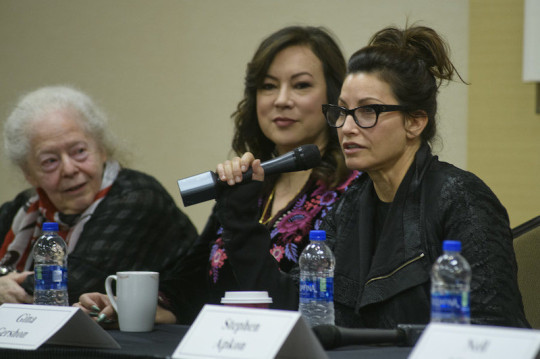
The second panel focused on "Women in Cinema: Hollywood or Independent, Does it Make a Difference," and featured such speakers as Alliance of Women Film Journalists president Jennifer Merin, "Bound" stars Jennifer Tilly and Gina Gershon... They too offered practical suggestions for how to increase the representation of women in cinema, both in front of and behind the camera.
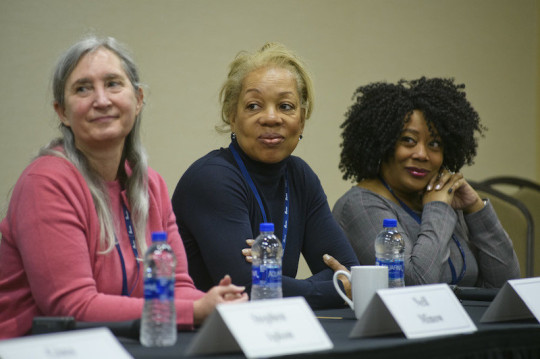
...RogerEbert.com Assistant Editor Nell Minow, "Maya Angelou and Still I Rise" director Rita Coburn and "The Curvy Critic" Carla Renata (filmmaker Stephen Apkon and Sony Pictures Classics co-president Michael Barker were also present).
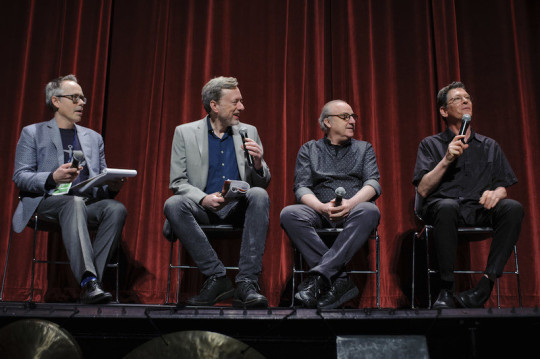
Alloy Orchestra members Ken Winokur and Terry Donahue chatted onstage with Michael Phillips and Todd Rendleman following their live musical accompaniment of a silent screen classic, in this case, Jean Epstein's 1923 melodrama, "Coeur fidèle" ("The Faithful Heart"). The third member of their trio, Roger Miller, was busy selling their priceless merchandise in the festival's boutique.

The Alloy Orchestra has performed at Ebertfest for over 16 years and are always brought back by popular demand. They compose original scores for the silent films they select, even making some of the instruments they use. What a talented group. We are fortunate to have them.

Both of the morning panels were reflected in the second film of the day, and Sony Pictures Classics Co-President, Michael Barker, delivered an amazing homage to the late Jonathan Demme's 2008 masterwork, "Rachel Getting Married." It featured Anne Hathaway in what I still consider her best performance, as a struggling addict returning home for her sister's wedding. This film is phenomenal with a cast including Rosemarie DeWitt, Bill Irwin, Debra Winger, Anna Deveare Smith, Tunde Adebimpe and many others. Demme considered it one of his favorites in contributing to the understanding of human behavior. It shows how whole families become dysfunctional and act out in various ways, but how facing up to addiction, admitting wrongs, making amends, forgiveness and love can help you face the very messiness of life and come together as a family and community. Michael Barker is without a doubt one of Ebertfest's favorite guests.

Barker spoke onstage after the film with our critic, Nell Minow, and one of Demme's closest friends, Stephen Apkon, a recipient of the Roger Ebert Humanitarian Award for his documentary, "Disturbing the Peace." The screenwriter of "Rachel Getting Married," Jenny Lumet (the granddaughter of Lena Horne and the daughter of Sidney Lumet), joined in the conversation over the satellite.
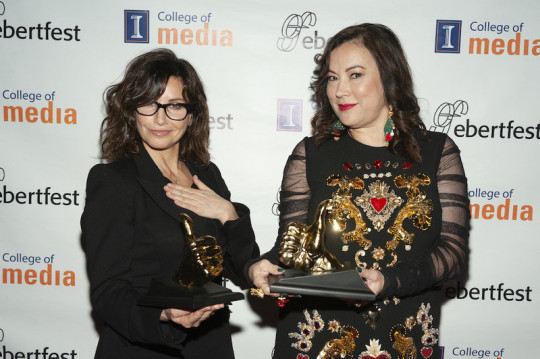
Lana and Lilly Wachowski's hugely enjoyable debut feature, "Bound," was the evening's cinematic treat, and it was made ten times more entertaining by the Q&A afterward with Gina Gershon and Academy Award nominee Jennifer Tilly. Their banter with critics Chuck Koplinski and Pamela Powell was a joy to watch.
DAY THREE
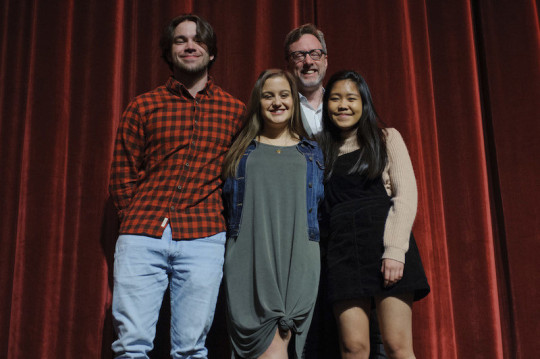
Michael Phillips introduced the audience to the 2018-19 University of Illinois College of Media Roger Ebert Fellows, Curtis Cook, Pari Apostolakos and Eunice Alpasan, who did a splendid job covering their first full Ebertfest experience. Although Phillips is the film critic for the Chicago Tribune, he is the revered mentor for the Ebert Fellowship program at the University of Illinois, and is valued for his knowledge and experience and his love of teaching. He makes the program better every year.
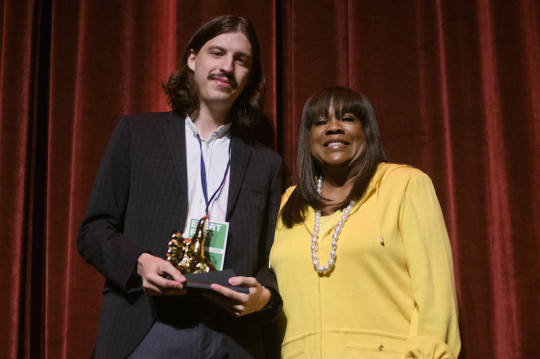
One of our longtime Ebertfest guests, Sam Fragoso, was encouraged by Roger to keep doing what he loved, and he is now an accomplished critic, podcaster and filmmaker. His wonderful short film, "Sebastian," preceded the first feature screened on Day 3 of Ebertfest, and earned him the coveted Golden Thumb.

Pawel Pawlikowski's ravishing Polish romance, "Cold War," was the discussion topic for Festival Director Nate Kohn, Michael Phillips and Carla Renata, following the morning screening. Carla Renata interviewed the film's director and shared some revealing insights into the movie. It was partially based on Pawlikowski's parents' tempestuous love story and is an epic told over several decades. Renata is also a recurring actress on ABC's Superstore, and just published a book for actors on marketing.
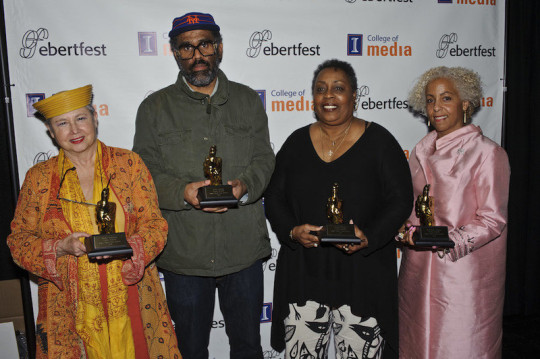
Horace Jenkins' newly restored 1982 gem, "Cane River," brought out a stellar quartet of talents: producer Sandra Schulberg, actress Tommye Myrick and Jenkins' children, Sacha and Dominique Jenkins. This film is a modern day Romeo & Juliet played out in Louisiana among descendants of African-American Creoles and slaves. It is a tale of colorism, land ownership, and a young woman's determination to pursue her education, but above all, it a tale of love. Very romantic. Ms. Myrick hilariously told us how she had to learn to swim and ride horses because she couldn't do either and the film required both. Schulberg told us how she preserved to get the film restored. And Dominique and Sacha told us of their remarkable father whose life itself is worthy of a film.
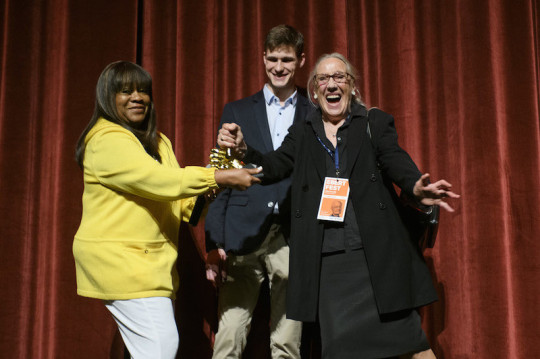
The great Polish actress, Madame Maja Komorowska, traveled all the way from Warsaw to attend our Ebertfest screening of Krzysztof Zanussi's 1984 love story, "A Year of the Quiet Sun," which paired her with the late Scott Wilson, to whom this year's festival was dedicated. She was joined on stage by her amusing translator, Jerzy Tyszkiewicz, who also happens to be her grandson.
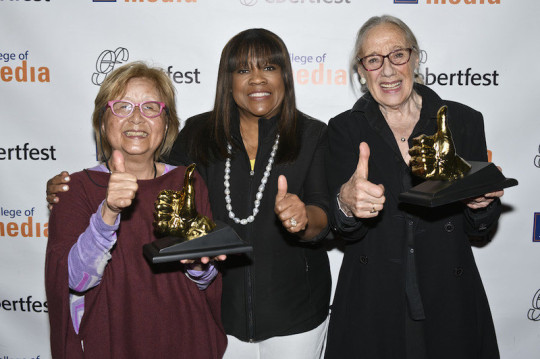
Their Q&A was moderated by Professor Todd Rendleman and Jennifer Merin. After tribute clips of Scott Wilson's film career, his widow, Heavenly Wilson, spoke of getting this movie made in Poland and at Monument Valley in the United States.

Here Maja Komorowska and Jerzy are joined by Scott's widow, Heavenly Wilson. Getting to spend time with them was heavenly indeed. It has become an Ebertfest tradition for guests and audiences to pose with the sculpture of Roger on the plaza of the Virginia Theater. The sculpture is by artist Rick Harney and was installed by the fundraising efforts of festival donors Donna and Scott Anderson. It was truly a gift from the heart, as Donna woke up in the hospital when she was having a heart transplant and said she wanted to do whatever it took to get a sculpture of Roger near the Virginia Theater as a gift to the community.
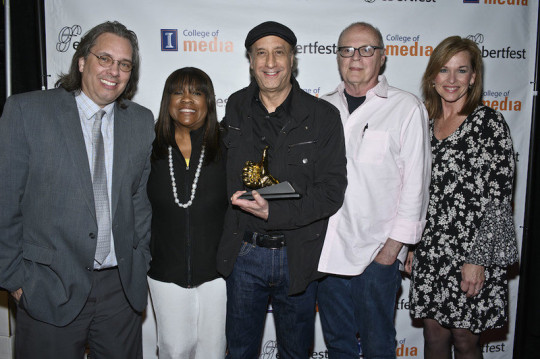
Iconic "Simpsons" producer David Mirkin brought down the house with his beloved 1997 comedy, "Romy and Michele's High School Reunion." Festival Director Nate Kohn appears here with film critics and broadcasters Chuck Koplinski and Pamela Powell who had a ball chatting with David Mirkin onstage.The audience loved seeing Lisa Kudrow and Mira Sorvino in their screwball roles. Mirkin presented an image of high school that so many can relate to. He was a delightful guest.
DAY FOUR
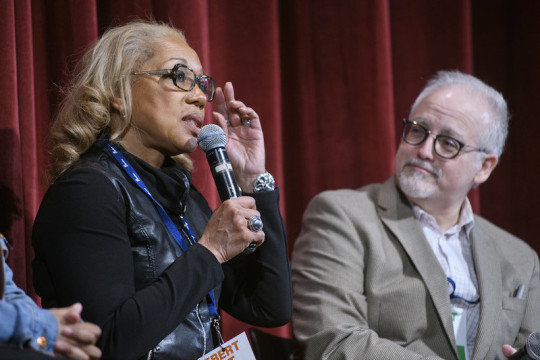
Beginning the last day of Ebertfest 2019 were two films about heroic figures who have left an indelible imprint in our culture long after their passing. The first was "Maya Angelou and Still I Rise," directed by Rita Coburn, who spoke onstage with our Editor at Large Matt Zoller Seitz and Ebert Fellow Whitney Spencer afterward. Rita Coburn, in a surprise, was presented with the inaugural ICON award, for the scope of her film about the iconic Maya Angelou, and her contributions to humanity. This was the first ICON award ever given at Ebertfest. Rita Coburn is actually one of those phenomenal women that Angelou talks about. The film was awarded a Peabody among other awards.
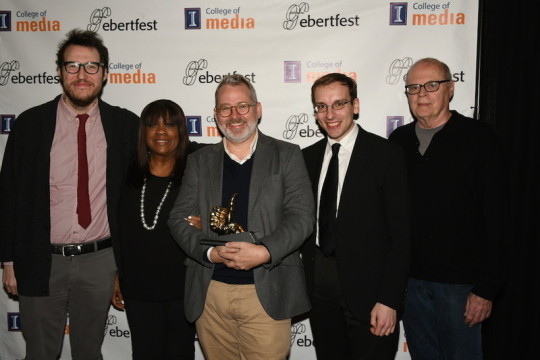
Director Morgan Neville won the Ebert Humanitarian award for his film, "Won't You Be My Neighbor?" about the television trailblazer and radical humanist Fred Rogers. It was only the third humanitarian award given. The second was given to Norman Lear for his lifetime of work in television in highlighting the various nuances of the human condition through humor. Neville was joined onstage by RogerEbert.com Assistant Editors Nick Allen and Matt Fagerholm, who were both great admirers of the movie. Matt movingly shared with the audience the letter he wrote to Mr Rogers when he was five years old, and also the amazingly long and very specific response Mr Rogers wrote back to five-year-old Matt in encouragement. It illustrated the respect Mr Rogers had for children and his principle of radical kindness.
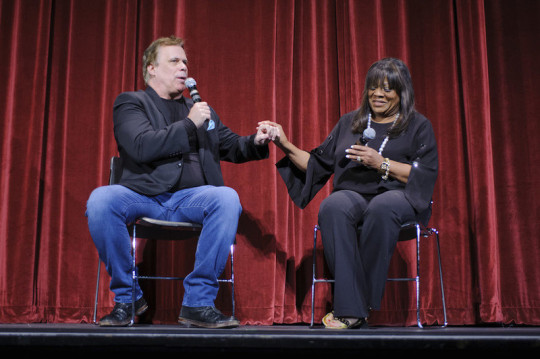
Our festival culminated with a celebration of Roger's longtime on-air "At the Movies" partner, Richard Roeper. A montage of hilarious and touching highlights from their reviews preceded my conversation with him onstage. Richard chose two films to present at Ebertfest, and both were well received: "Almost Famous," and "Sideways." Richard's career includes broadcasting on radio and television and other platforms, publishing books about movies and gambling, and lecturing. He may also be working on future movie projects.
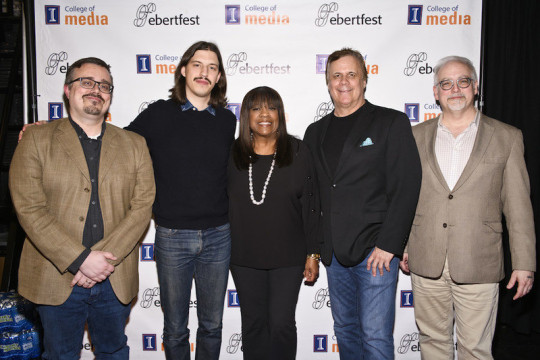
RogerEbert.com Managing Editor Brian Tallerico and Editor at Large Matt Zoller Seitz chatted with Richard Roeper and Sam Fragoso about one of their favorite movies, Cameron Crowe's "Almost Famous," a film very close to Roger's heart (and his own life story). Crowe provided a special video introduction to the picture that was appreciated by the whole audience. His film still plays well all these years later, with an luminous performance by Kate Hudson, and an unbelievably perfect cast, including Billy Crudup, Phillip Seymour Hoffman, Jason Lee and the vulnerable newcomer Patrick Fugit.
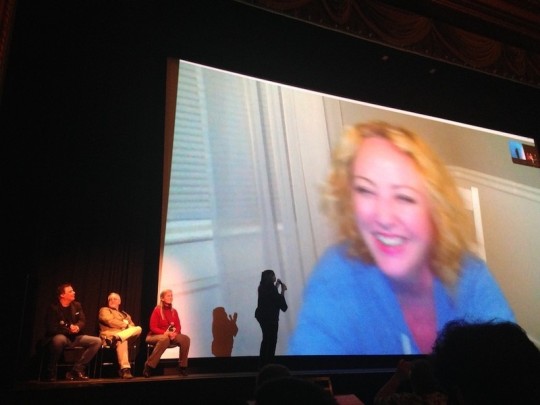
Photo by Matt Fagerholm
Last but certainly not least, we screened one of Roeper's most prized films he ever got to review with Roger, Alexander Payne's "Sideways." The film's Oscar-nominated star, the beautiful Virginia Madsen, joined us via Skype from the set of her new TV series, "Swamp Thing," for an emotional conversation about Roger and his championing of the film. The film starred Paul Giamatti, Thomas Haden-Church and the unforgettable Sandra Oh. Virginia shared many insights, including about drinking fabricated fake wine. Hilarious. Richard Roeper, Matt Zoller Seitz and Nell Minow were on hand for the discussion. All in all, a perfect end to another unforgettable Ebertfest. Join us April 15th through April 18th next year for the 22nd anniversary of Roger Ebert's Film Festival!
from All Content http://bit.ly/2Pp5a7S
0 notes
Text

Chetney using his Grim Psychometry
Critical role campaign 3 episode 74 at 3:01:58 time.
“You sense that this object, Once belonged to an old soldier, who had, Accepted the demise of their innocence…”
#critical role#art#bells hells#chetney pock o'pea#fandom critical#drawing#sketch#critical role champaign 3#critical role fanart
61 notes
·
View notes
Text
Gwendolyn Brooks
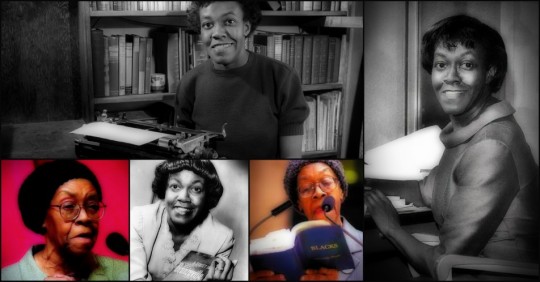

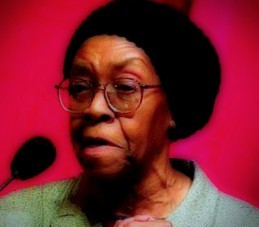

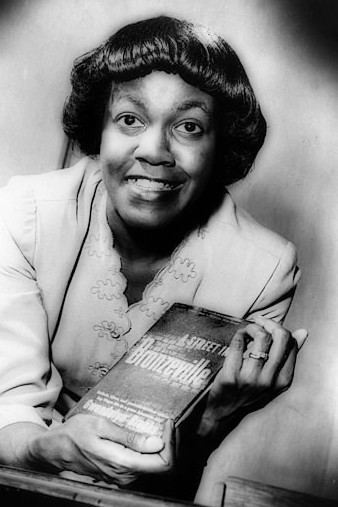

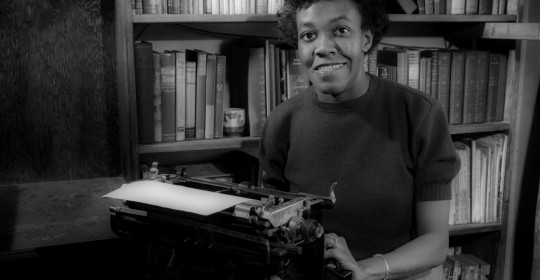
Gwendolyn Elizabeth Brooks (June 7, 1917 – December 3, 2000) was an American poet, author, and teacher. She was the recipient of many awards for her work and influence; including the Pulitzer Prize for Poetry on May 1, 1950, making her the first African American woman to receive that award.
Throughout her career Brooks received many more honors. She was appointed Poet Laureate of Illinois in 1968, a position held until her death, and Poet Laureate Consultant in Poetry to the Library of Congress in 1985.
Early life
Gwendolyn Elizabeth Brooks was born on June 7, 1917, in Topeka, Kansas, and died on December 3, 2000 in Chicago, IL. She was the first child of David Anderson Brooks and Keziah (Wims) Brooks. Her father was a janitor for a music company who had hoped to pursue a career as a doctor but sacrificed that aspiration to get married and raise a family. Her mother was a school teacher as well as a concert pianist trained in classical music. Family lore held that her paternal grandfather had escaped slavery to join the Union forces during the American Civil War.
When Brooks was six weeks old, her family moved to Chicago during the Great Migration; from then on, Chicago remained her home. According to biographer Kenny Jackson Williams, Brooks first attended a prestigious integrated high school in the city with a predominantly white student body, Hyde Park High School, transferred to the all-black Wendell Phillips High School, and then moved to the integrated Englewood High School. After completing high school, she graduated in 1936 from Wilson Junior College, now known as Kennedy-King College. Due to the social dynamics of the various schools, in conjunction with time period in which she attended them, Brooks faced racial injustice that over time contributed to her understanding of the prejudice and bias in established systems and dominant institutions in her own surroundings as well as ever relevant mindset of the country.
Brooks began writing at an early age and her mother encouraged her saying, ''You are going to be the lady Paul Laurence Dunbar."
After these early educational experiences, Brooks never pursued a four-year degree because she knew she wanted to be a writer and considered it unnecessary. "I am not a scholar," she later said. "I'm just a writer who loves to write and will always write." She worked as a typist to support herself while she pursued her career.
She would closely identify with Chicago for the rest of her life. In a 1994 interview, she remarked on this,
"(L)iving in the city, I wrote differently than I would have if I had been raised in Topeka, KS...I am an organic Chicagoan. Living there has given me a multiplicity of characters to aspire for. I hope to live there the rest of my days. That's my headquarters.
Career
Writing
Brooks published her first poem, "Eventide", in a children's magazine, American Childhood, when she was 13 years old. By the age of sixteen she had already written and published approximately seventy-five poems. She received commendations on her poetic work and encouragement from James Weldon Johnson and later, Langston Hughes, both well-known writers with whom she kept communication with and whose readings she attended in Chicago. At seventeen, she started submitting her work to "Lights and Shadows," the poetry column of the Chicago Defender, an African-American newspaper. Her poems, many published while she attended Wilson Junior College, ranged in style from traditional ballads and sonnets to poems using blues rhythms in free verse.
Her characters were often drawn from the inner city life that Brooks knew well. She said, "I lived in a small second-floor apartment at the corner, and I could look first on one side and then the other. There was my material."
By 1941, Brooks was taking part in poetry workshops. A particularly influential one was organized by Inez Cunningham Stark, an affluent white woman with a strong literary background. Stark offered writing workshops to African-Americans on Chicago's South Side, which Brooks attended. It was here she gained momentum in finding her voice and a deeper knowledge of the techniques of her predecessors. Renowned poet Langston Hughes stopped by the workshop and heard Brooks read "The Ballad of Pearl May Lee." Brooks continued to work diligently at her writing and growing the community of artists and writers around her as her poetry began to be taken more seriously. She and her husband frequently threw parties at their apartment at 623 E. 63rd Street and it was in the kitchenette of that apartment that Brooks hosted a party for her friend and mentor Langston Hughes. Once he unexpectedly dropped in and famously shared a meal of mustard greens, ham hocks, and candied sweet potatoes with Brooks and her husband Henry Blakely.
Brooks' published her first book of poetry, A Street in Bronzeville (1945), with Harper and Row, after strong show of support to the publisher from author Richard Wright. He said to the editors who solicited his opinion on Brooks' work:
"There is no self-pity here, not a striving for effects. She takes hold of reality as it is and renders it faithfully.... She easily catches the pathos of petty destinies; the whimper of the wounded; the tiny accidents that plague the lives of the desperately poor, and the problem of color prejudice among Negroes."
The book earned instant critical acclaim for its authentic and textured portraits of life in Bronzeville. Brooks later said it was a glowing review by Paul Engle in the Chicago Tribune that "initiated My Reputation." Engle stated that Brooks' poems were no more "Negro poetry" than Robert Frost's work was "white poetry." Brooks received her first Guggenheim Fellowship in 1946 and was included as one of the “Ten Young Women of the Year” in Mademoiselle magazine.
In 1953, Brooks published her first and only narrative book, a novella titled Maud Martha, which in a series of thirty-four small vignettes, follows the life of a black woman named Maud Martha in detail as she moved about life from childhood to adulthood. It tells the story of "a woman with doubts about herself and where and how she fits into the world. Maud's concern is not so much that she is inferior but that she is perceived as being ugly," states author Harry B. Shaw in his book, Gwendolyn Brooks. Maud suffers prejudice and discrimination not only from white individuals but also from black individuals who have lighter skin tones than hers, something that is direct reference to Brooks' personal experience. Eventually, Maud stands up for herself by turning her back on a patronizing and racist store clerk. "The book is ... about the triumph of the lowly," Shaw comments.
In 1967, the year of Hughes' death, Brooks attended the Second Black Writers' Conference at Nashville's Fisk University. Here, according to one version of events, she met activists and artists such as Imamu Amiri Baraka, Don L. Lee and others who exposed her to new black cultural nationalism. Recent studies argue that she had been involved in leftist politics in Chicago for many years and, under the pressures of McCarthyism, adopted a black nationalist posture as a means of distancing herself from her prior political connections. Brooks' experience at the conference inspired many of her subsequent literary activities. She taught creative writing to some of Chicago's Blackstone Rangers, otherwise a violent criminal gang. In 1968 she published one of her most famous poems, In the Mecca, a long poem about a mother's search for her lost child in a Chicago apartment building. The poem was nominated for the National Book Award for poetry.
Brooks' second book of poetry, Annie Allen (1950), focused on the life and experiences of a young Black girl as she grew into womanhood in the Bronzeville neighborhood of Chicago. The book was awarded the Pulitzer Prize for poetry; she also was awarded Poetry magazine's Eunice Tietjens Prize.
Her autobiographical Report From Part One, including reminiscences, interviews, photographs and vignettes, came out in 1972, and Report From Part Two was published in 1995, when she was almost 80.
Teaching
Brooks said her first teaching experience was at the University of Chicago when she was invited by author Frank London Brown to teach a course in American literature. It was the beginning of her lifelong commitment to sharing poetry and teaching writing.
Brooks taught extensively around the country and held posts at Columbia College Chicago, Northeastern Illinois University, Chicago State University, Elmhurst College, Columbia University, City College of New York, and the University of Wisconsin–Madison.
On May 1, 1996, Brooks returned to her birthplace of Topeka, Kansas. She gave the keynote speech for the Third Annual Kaw Valley Girl Scout Council's "Women of Distinction Banquet and String of Pearls Auction."
Archives
The Rare Book & Manuscript Library (University of Illinois at Urbana-Champaign) acquired Brooks' archives from her daughter Nora. In addition, the Bancroft Library at UC Berkeley has a collection of her personal papers, especially from 1950 to 1989.
Family life
In 1939, Brooks married Henry Lowington Blakely, Jr. They had two children: Henry Lowington Blakely III, born on October 10, 1940; and Nora Blakely, born in 1951.
From mid-1961 to late-1964, Henry III served in the U.S. Marine Corps, first at Marine Corps Recruit Depot San Diego and then at Marine Corps Air Station Kaneohe Bay. During this time, Brooks mentored his fiancée, Kathleen Hardiman, today known as anthropologist Kathleen Rand Reed, in writing poetry. Upon his return, Blakely and Hardiman married in 1965. Brooks had so enjoyed the mentoring relationship that she began to engage more frequently in that role with the new generation of young black poets.
In the year 1990, her works were given a permanent home when Chicago State University established the Gwendolyn Brooks Center for Black Literature and Creative Writing on campus. On her eightieth birthday, in 1997, Brooks was honored with tributes from Chicago to Washington, D.C. Gwendolyn Brooks died of cancer at her Chicago home on December 3, 2000.
Honors and legacy
1946, Guggenheim Fellow in Poetry
1946, American Academy of Arts & Letters Award
1950, Pulitzer Prize in Poetry
1968, appointed Poet Laureate of Illinois, a position she held until her death in 2000
1976, the Shelley Memorial Award of the Poetry Society of America
1985, selected as the Consultant in Poetry to the Library of Congress, an honorary one-year position whose title was renamed the next year to Poet Laureate
1988, inducted into the National Women's Hall of Fame
1989, recipient, Life Time Achievement Award from the National Endowment for the Arts.
1989, awarded the Robert Frost Medal for lifetime achievement by the Poetry Society of America
1992, awarded the Aiken Taylor Award by the Sewanee Review
1994, chosen as the National Endowment for the Humanities' Jefferson Lecturer, one of the highest honors in American literature and the highest award in the humanities given by the federal government.
1994, Recipient of the National Book Foundations's Medal for Distinguished Contribution to American Letters
1995, presented with the National Medal of Arts
1995, honored as the first Woman of the Year chosen by the Harvard Black Men's Forum
1995, received the Chicago History Museum "Making History Award" for Distinction in Literature
1997, awarded the Order of Lincoln award from The Lincoln Academy of Illinois, the highest honor granted by the State of Illinois
Brooks also received more than 75 honorary degrees from colleges and universities worldwide.
Legacy
1970: "For Sadie and Maud" by Eleanor Holmes Norton, included in Sisterhood is Powerful: An Anthology of Writings From The Women's Liberation Movement (1970), quotes all of Brooks' poem "Sadie and Maud"
1970: Gwendolyn Brooks Cultural Center, Western Illinois University, Macomb, Illinois
1995: Gwendolyn Brooks Elementary School, Aurora, Illinois
1990: Gwendolyn Brooks Center for Black Literature and Creative Writing, Chicago State University
2001: Gwendolyn Brooks College Preparatory Academy, Chicago, Illinois
2001: Gwendolyn Brooks Middle School, Harvey, Illinois
2002: Gwendolyn Brooks Middle School, Oak Park, Illinois
2003: Gwendolyn Brooks Illinois State Library, Springfield, Illinois
2002: 100 Greatest African Americans
2004 Gwendolyn Brooks Park named by the Chicago Park District, 4542 S. Greenwood Ave. Chicago IL 60653
2005: Gwendolyn Brooks Middle School, Bolingbrook, Illinois
2012: Honored on a United States' postage stamp.
Wikipedia
12 notes
·
View notes
Photo
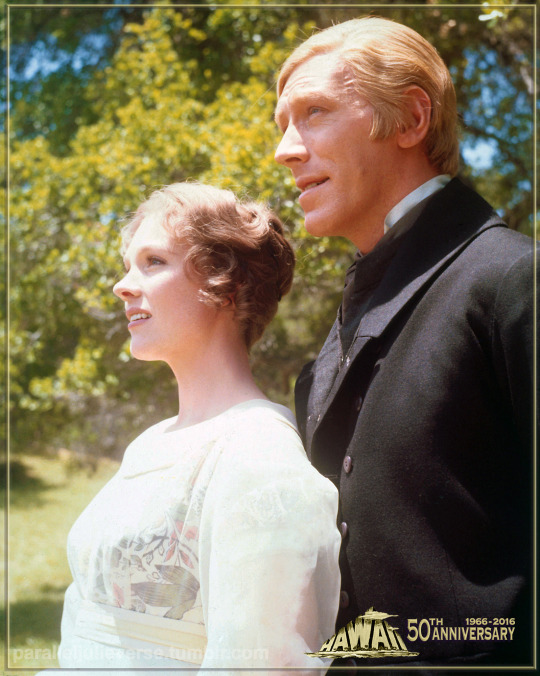



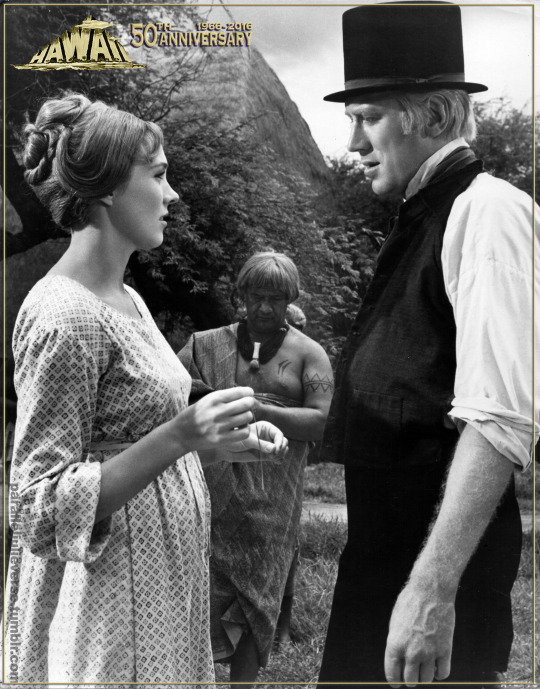

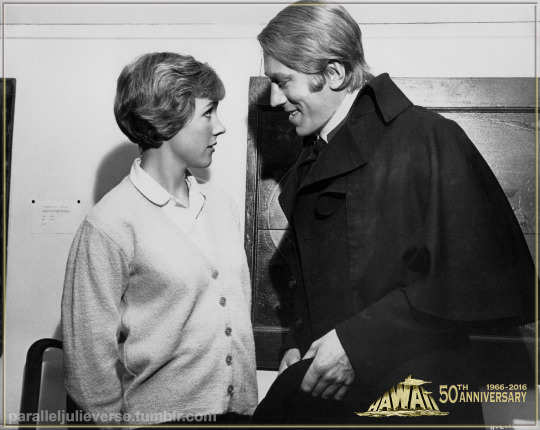


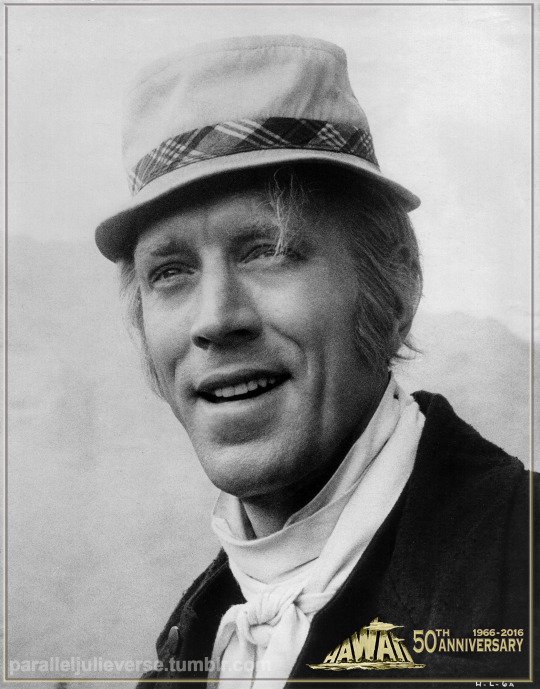
Whenever she is faced with the stock interview question about her “leading men” and which was her favourite, star Julie Andrews inevitably demurs with characteristic diplomacy. All her male leads are glossed as “divine” and “dishy” and each one praise for having taught her “something different” (Cottrell, 166). Even notorious terrors like Rex Harrison are tactfully recalled as “charismatic” and “fascinating” and “for that one forgave him everything” (Andrews, 224).
If pressed, however, Julie will occasionally allow herself to discriminate, and one male co-star she seems happy to single out for special kudos is Max von Sydow, the acclaimed Swedish actor who played opposite her in Hawaii (1966) and, again twenty years later, in Duet for One (1986).
“He was the unqualified front runner – the most generous man I have ever met. And he had such a lovely light sense of humour. I consider it a privilege to have worked with him” (Wilson, 23).
At the time of their initial collaboration on Hawaii, von Sydow – who was already a film actor of note in European art cinema – was only beginning to come to the attention of mainstream American audiences courtesy of his first Hollywood foray playing Jesus Christ, no less, in the Biblical epic, The Greatest Story Ever Told (1965). Julie had also not long made her own high-profile film debut in Mary Poppins – for which she would in fact receive the Oscar during the early stages of Hawaii‘s production. That both she and von Sydow came to the film on the back of such splashy Hollywood bows inspired the actress to joke, “We should be a great team…I can fly and he can walk on water” (Archerd, 22).
Wry quips like this quickly endeared Julie to von Sydow, who shared a similar sense of puckish humour. Visitors to the set of Hawaii commented on how well the pair got on and how they both had a mutual “flair for comedy which they delight[ed] in springing on unsuspecting conversationalists” (Archerd, 22). Years later, von Sydow would describe Julie admiringly as “one of the most irreverent and witty women I’ve ever known” (Warga, 18).
Julie was equally fulsome in her praise of von Sydow. “He’s one of the nicest men who ever walked,” she enthused, “No pretense–a love!” (Hopper, III-5). “I have worked with wonderful leading men but Max has to be the superlative of superlatives,” she gushed in a later interview, “he is generous, he’s compassionate. These qualities really lay you out flat” (Battele, 36). She got on so well with her new leading man that she feared “Max has spoiled me for working with anybody else” (Oppenheimer, 7).
The star pair’s off-screen rapport certainly helped infuse their on-screen performances with genuine chemistry and heartfelt warmth. As profiled in an earlier post, reviews of Hawaii were decidedly mixed but most critics lauded the two leads. “Max Von Sydow is superb…and the versatile Julie Andrews proves the perfect counterpart,” wrote the Courier-Post (”Michener Epic”, 41 ). Von Sydow’s “performance is a potent one,” averred the reviewer for The Philadelphia Inquirer, and “Julie Andrews…gives the very needed warmth to ‘Hawaii’” (Murdock, 37). The St Louis Post Dispatch similarly argued: “Max von Sydow…gives a superb performance…So too does Julie Andrews come through with a sterling job of acting as his patient bride” (G4). Even Vincent Canby of The New York Times who thought the film plodding and “a bit of a bore”, wrote that “Mr. Von Sydow is a fascinating actor…and Julie Andrews is both strong-jawed and appealing as his long-suffering wife. Together they contribute the film’s few moments of genuine emotion”(51).
Given their obvious on- and off-screen simpatico, it’s a shame that Julie and von Sydow waited two full decades before appearing together in another film…and an even greater shame that their subsequent collaboration, Duet for One (1986), largely sank without a trace.* Mind, the two would have worked together much sooner had von Sydow had his way. They apparently remained in quite close contact for some time after the end of filming on Hawaii. Von Sydow and his family stayed with Julie in her Los Angeles home when they came for the West Coast premiere of the film (Muir, 5-B), and a few months later von Sydow escorted Julie’s mother, Barbara to the London premiere in Julie’s absence (Grahame, 27).
Press reports from late 1966 and early 1967 reveal that von Sydow – who was allegedly keen to ‘lighten’ his own screen image, as well as branch into movie producing (Archerd, 22) – had purchased the film rights to “Champaign Suite”, by Swedish comedy writer, Nils Hergaard and he had “already begun negotiations with Julie Andrews, his co-star from ‘Hawaii’, about the feminine lead in the film” (“Movie Call Sheet”, 43). Other reports state he was also in discussions with George Roy Hill to direct and Fred MacMurray to co-star (Bradford, 18). Unfortunately, we haven’t been able to find much further information on this unrealised project but it is just the kind of tidbit of intriguing “what if” trivia that the Parallel Julieverse adores…so watch this space!
Notes:
* Duet for One will surely be the subject of a future post but, in this context, it’s interesting to note that the film – while criminally mismanaged by studio, Cannon Films, then on the verge of insolvency – met a similar critical reception to that of Hawaii twenty years earlier. Reviewers were generally lukewarm on the property itself but had nothing but praise for the central performances. Kevin Thomas of The Los Angeles Times, for example, described Duet for One as
“a four-hankie drama of the past…[that] is uneven at best…[and] only works thanks to Andrews’ vibrant presence and sheer professionalism….‘Duet for One’ comes alive when Andrews and Von Sydow spar as equals in character and intelligence. Defeatingly, their confrontations are infrequent and so brief they seem truncated…You’re left wishing Julie Andrews got to run the gamut in more rewarding circumstances” (V-8).
Sources:
Andrews, Julie. Home: A Memoir of My Early Years. New York: Hyperion, 2008.
Archerd, Army. “Sydow Eyes Comedy But Will Have to Wait.” The Journal News. 20 September 1965: 22.
Battelle, Phyllis. “A Good Role Never Lets Julie Alone.” Philadelphia Daily News. 17 August 1965: 36.
______________. “The Julie Andrews Nobody Knows: ‘Socko, Boffo, Whammo’ for Leading Men.” Philadelphia Daily News. 30 September 1965: 36.
Bradford, Jack. “Notes from Hollywood.” The Pasadena Independent. 6 January 1967: 18.
Canby, Vincent. “Screen: ‘Hawaii,’ Big, Long Film, Has Its Premiere.” The New York Times. 11 October 1966: 54.
Cottrell, John. Julie Andrews: The Story of a Star. London: Arthur Barker, 1968.
Graham, Sheilah. “Hollywood ‘N Everywhere.” Sunday Star-Bulletin and Advertiser. 8 January 1967: 27.
Hopper, Hedda. “Who Will Be ‘Last Duchess’?” The Los Angeles Times. 29 May 1965: III-5.
“Michener Epic, ‘Hawaii’ Reaches a Big Finish.” The Courier-Post. 26 October 1966: 41.
Muir, Florabel. “Hollywood and Vine.” The Times. 9 August 1966: 5-B.
____________. “Best of Hollywood.” The Philadelphia Inquirer. 28 December 1966:
Murdock, Henry T. “3-Hour-Plus ‘Hawaii’ Portrays a Small Part of Michener’s Novel.” The Philadelphia Inquirer. 26 October 1966: 37.
Oppenheimer, Peer J. “Is He the World’s Best Actor?” Family Weekly, The Newspaper Magazine. 2 October 1966: 6-7.
Standish, Myles. “The New Films.” St Louis Post-Dispatch. 30 October 1966: G4.
Terry, Clifford. “Acting and Scenery Help ‘Hawaii’ Thru Three Long Hours.” The Chicago Tribune. 20 October 1966: 2-1.
Thomas, Kevin. “‘Duet for One’: A Four-hankie Drama Of The Past.” The Los Angeles Times. 25 December 1986: V-8.
Tobin, Riv. “‘Hawaii’ Film Personalities on the Go.” The Sunday Star-Bulletin and Advertiser. 19 September 1965: D6.
“Movie Call Sheet: Von Sydow Buys Comedy.” The Los Angeles Times. 17 December 1966: 43
Warga, Wayne. “‘Emigrants’ a Labor of Love for Sydow.” The Los Angeles Times. 29 October 1972: Calendar 18
Wilson, Jane. “Thoroughly Wholesome Julie.” The Sunday Times Magazine. 8 October 1967: 12-23.
© 2017, Brett Farmer. All Rights Reserved.
#julie andrews#max von sydow#hawaii#fiftieth anniversary#hollywood#film history#epic#star friends#George Roy Hill
30 notes
·
View notes
Text
CAPE TOWN ART FAIR QUESTIONNAIRE
1. Stevenson’s booth was split in half. They had a Penny Siopis work, similar to at the gallery. They did not have any labels of the works being exhibited. No names or titles. This was different. It felt more informal. The gallerists were unfamiliar.
Goodman Gallery had a square booth which felt like a closed room. It was quite formal and felt business-like. This was similar to their Gallery, which also had an air of formality about it. There were table and chairs in the centre. The works exhibited were different to the works at their gallery, in artist and style. The gallerist was familiar. They had their works titled on card.
Blanc had a large closed space, it felt like a spacious room. They had new works to the ones displayed at the gallery, but they still had a sort of minimal feeling, similar to the gallery show. The gallerist was familiar and she mentioned that they had planned their booth beforehand as a machete. I thought the space was the best executed. The works were titled on clear vinyl.
2. I liked:
Thierry Fontaine, The Long Crossing, 2005.
A photograph of two shoes with spikes added to them. I liked the composition of the image and the juxtaposition of formality with a sense of darkness and anger. The contrast was striking and dynamic.
Carolyn Parton, Notes on the Wind, 2018.
Reconstituted paint strata bent into flowing swirls in a fashion reminiscent to Van Gogh, yet an abstract ‘textural’ piece. I saw a lot of textural works this year and I enjoyed seeing mediums used in new ways like in this piece.
Vanessa Beecroft, vb.paulina. 005.fs.pol, 2014.
An image of a Mexican woman with her face painted gold. She was wearing white, in front of a white background. Her black hair contrasted with the white background. I liked the image firstly because the face paint and composition was eye catching and well composed. Her expression was captivating and she was not looking at the camera.
I disliked.
Ettore Spalletti, Azzuro quiete del pomeriggio, 2016.
The work was a solid pale blue square, painted onto wood. While I enjoy minimalism, the piece did not speak to me. It was too small for the colour to have a big impact like in other solid colour works such as by Mark Rothko. It also seemed like a bleak attempt at modern revival.
Donna Kukama, One day we will fall apart together again, 2018.
White cursive writing over a black background. The medium appeared to be chalk. I didn’t like the way that the text was written, it felt too frilly and didn’t balance well. I thought it lacked emotion, which didn’t align with the pieces emotional title.
Sitaara Stodel, Smith. A solo exhibition.
Collage created from images of Southern Suburbs houses. I wasn’t mad about the composition, I thought it was too reminiscent of other collage I’ve seen over the years. They looked quickly done. I’m generally not that fond of collage though, for me it needs to really stand out or try to use the medium exploratively to grasp me.
3. From what I saw, there was a lot of exploration of texture, and works that made unique use of mediums. A lot of works mimicked other textures, and many more simply used materials in new ways, drawing focus to the medium. There were also a lot of paintings and hanging pieces.
4. I preferred booths that created a closed squarish space, as I felt it contained the works. Some booths were very ‘airy’ and open, split up. This made the space confusing to me. The artworks were mostly hung in similar ways, though I tended not to enjoy it if they were hung above eye level. Most booths didn’t have furniture. When they did, I felt it made it seem commercial and corporate and detracted from the art. It made a space to either sit down, or to purchase, not to look,.
5. Works titles differed between stickers and card. They were all labeled at the top on the side, some had different colours according to their areas. Stevenson was the only booth without piece titles, and they had written with pencil on the walls. That made me feel like they didn’t take the fair seriously and it annoyed me.
6. They kept landmarks, like the VIP section, the bar and the bathroom in separate corners of the room. This made it easy to navigate as it divided the space into quadrants. The art booths were split in ways that made it easy to pass through, and there were passageways to walk. It was laid out well. The VIP section was badly placed as you could not walk around when at Bad Paper. It was a sort of bouncer barred dead end for anyone without a pass.
7. The white lighting was bright and white. It was quite clinical, but reminiscent of art gallery lighting. It was easy to see the works. I liked the lighting.
8. People at the fair tended to be dressed smart casual. There was a lot of light, thin fabrics and flowing, and loose fit clothing. And in contrast, a few wore well fitted, smart looks. There was general summer vibe. Gallerists tended to wear their own clothes and styles, but all looked very presentable. The whole fair was quite stylish fashionably
9. There was the bar that sold expensive salads, cakes, quiches and drinks. Wine and champaign was readily available. There were book markets too that stocked a nice collection of coffee-table-style creative publishes. The whole fair was expensive and definitely appealed to the upperclass to upper middle class.
10. Tabita Rezaire, Inner Fire: BBHMM, 2016.
This piece deliberately exhibits the spectacle of wealth with images of money and gold slabs. The artist is in the centre and there are words that read, ‘BITCHES BETTER HAVE MY MONEY,
FUCK YOU BUT PAY ME, ANTI CAPITALIST BAE CHASING THE MONEY, DESCENDANT OF A COMMODITY, #REPARATIONS’
The work is done in the style of millennial internet art culture. It draws attention to the embracing of exuberant displays of wealth within millennial society. A society very influenced by rap culture and conspicuous consumption.
11. Tabita Rezaire’s whole show feels like it ‘doesn’t it’. It is the only proper example of internet art and of millennial culture that I could find in the whole fair. She uses photoshop to create digital collages that ironically embrace commodification, exuberant spending and advertising through intertextual images copied and pasted in, as well as clear text. It was unique as it made no attempt to hide its role in the commodity market. The financial world and the art world have a tense relationship, and there is a lot of facade and trend. It was interesting to see that capitalist culture not hidden and concealed, but overtly praised and embraced in a ‘joking not joking’ sort of way.
12. It wasn’t hard at all. Gallerists were very friendly in getting the prices. I feel it is just something that gets asked a lot, so they don’t mind too much. It would have been interesting to ask the same gallerist a couple of times though.
“Um excuse me. Sorry to bother you again, but how much is this, this and this?”
13. The fair was sponsored by Investec, and the bar was sponsored by Boschendal wine estate.
14. The CTICC is a very large space and it is known for hosting high calibre events, such as the design indaba. It is well lit, well kept and has good parking and security. It is also situated in central Cape Town, close to the waterfront and the highway.
15. The oldest works I could find were photographs by Jesse A. Fernandez. The works were not titled, but the gallerist said they were taken in the 1950’s.
16. The youngest artist I found was Talia Ramkilawen, who was 23 years old.
17. The solo booths were mostly semi squares. They were the same size as many gallery booths. I enjoyed them because I could get more of a rounded view of the artist. I don’t just enjoy a work for the piece itself but also how it fits in contextually with the rest of the artists work, so in this way they were nice to see.
18. William Kentridge is always popping up. I have become very aware of Penny Siopis this year too, thanks to Stevenson.
As I learn more and can identify more artists without seeing their titles, I will become more alert and astute to this.
19. I couldn’t notice any trends in subject matter, as there was such a diverse variety of works. I would say there were more abstract works, and a lot more textural works than portraits. There were not a lot of landscapes at all. There was a lot of painting, as expected. But also a lot of photography and a lot of textural works that used mediums uniquely, or mimicked other textures.
20. I would be represented by Blanc as the is friendly. I like how much effort they put into their booth and they looked pleased to be at the fair. It wasn’t too formal, but it was still very well planned out. I also like the work on display, and the galleries was friendly.
21. I would also work for Blanc, for the same reasons. I am just generally fond of the gallery and I like that they made a machete of their space before hand. I would like to work with a team that is that committed.
22. I wondered how beneficial the fair was for ‘art’ itself. I feel a lot of people, myself included, (so maybe I am biased) left making more criticisms and observations about the art scene and the fair itself than the actual art. I think you could spend a day really diving into just twenty works in great deal and learn more than you could trying to take in everything at the fair. Once overwhelmed, one gravitates to the bar. I questioned the availability of free sparkling wine, as I always do. It is enticement. The same as the VIP section, satisfying status.
23. I would like to show at the fair. I enjoyed it and I thought it was a fun space. There was also a lot of interesting artworks and it was nice to see that. People there were cheerful, and I was too. So it was a mindful space, and a good environment to feel appreciative of what I saw. That is a good reason to want to show. My space would be a square room like space, because I noted that they were the most memorable. It gives you a chance to step out of the stream like flow of the fair and into a space that seems still. The artwork sits well like that. The four corners of a square space hold a stable energy to them. I would remember to title my works! I would not have furniture as it is corporate and distracting (to me). And I would make sure to have at least one sculpture in the centre of my space, as it creates a circular flow to walk in, around the piece.
0 notes
Text
We Are Never Ever Getting Sued For Copyright Infringement
By Jennifer Kuo, University of Illinois Urbana-Champaign Class of 2020
September 8, 2020

Many college students might remember owning Taylor Swift’s Fearless album on CD when it first came out in 2008, with tracks like “Love Story” and “You Belong With Me” becoming some of the most iconic songs of the decade. Fearless propelled Taylor Swift into stardom and made her one of the youngest artists to win a Grammy Award. Now, in 2020, Taylor Swift is as popular as ever, but her music releases are coming in a slightly different format. Her new surprise album, folklore, officially broke the world record a few days after its release for most one-day streams of an album by a female artist on Spotify, coming in at 80.6 million streams [1]. Streaming services have largely replaced CDs in the past few years, with Spotify being one of the most prominent players in the market. Despite folklore’s success on Spotify, Taylor Swift has had a fraught relationship with the streaming giant.
The artist payout model of Spotify, like many streaming services, is based on the number of streams multiplied by the company’s revenue and the artist’s royalty rate. 70% of Spotify’s artist payout goes to publishing owners, which means that on average an artist makes less than a cent per play, but this amount could end up in payouts of millions of dollars for a popular artist like Taylor Swift [2]. Despite this, Spotify has often come under attack for underpaying artists, and record labels have even demanded Congress enact mandatory minimum regulations targeting streaming services. Spotify leadership maintains, however, that its freemium-style service has made significant impact in decreasing the amount of online piracy of music, ultimately increasing legal exposure and publicity of artists and their earnings[3]. Though Spotify maintains its services ultimately leads to net increases in revenue for record labels and artists, Taylor Swift decided to pull all her music off the platform in 2014. In an op-ed in the Wall Street Journal, Swift groups streaming together with piracy and file sharing as actions that have decreased album sales and have dealt a blow to “the financial value that artists…place on their music.” Calling music “important and rare,” she maintained that providing music for free as Spotify does is undervaluing art. Swift is not alone in leaving Spotify; artists such as The Black Keys have also spoken out against the platform [4].
Surprisingly, Taylor Swift suddenly returned to Spotify three years after her departure in 2014, with little comment in reference to her earlier criticism of streaming services. If Spotify was a giant in 2014, by 2017 it had become a behemoth. With 100 million-plus listeners, it also holds the important role of supplying data to Nielsen which compiles Billboard weekly charts. With the way the music industry had changed, it made little financial sense for any artist to shun Spotify in spite of any ethical misgivings regarding its model [5]. In truth, artists and record labels have had a love-hate legal relationship with digital music services for decades, and these services have toed the line between IP violations and popularizing musical content since the granddaddy of it all, Napster. Napster revolutionized the music industry by enabling peer-to-peer file sharing through its software back in 1999. Unsurprisingly, Napster was shut down through A&M Records v. Napster Inc. less than two years later, accused of copyright infringement. However, in the short 14 months Napster was in business, it had already changed the music industry in many irreversible ways, although it was only a continuation of a trend that had been happening for years. In 1998, Congress enacted the Digital Millennium Copyright Act (DMCA) in response to rising piracy online. It is this act that legally enforced payment of a sound performance royalty as well as a musical work royalty, which directly impacts streaming services that allow users to play content on demand. Furthermore, the act also expanded upon definitions of. interactive subscription services to include not only on-demand services but also specially created programs. This definition expansion more broadly included streaming services and imposed on them an additional licensing fee requirement [6].
Spotify was founded in Sweden, and for many years had difficulty entering the US market due to the challenge of securing licensing rights to comply with the DMCA. In 2011, when it finally launched in the country, it immediately faced a lawsuit, not from record labels surprisingly, but rather from low profile mobile media company PacketVideo. The charge? Patent infringement, of the cloud-based streaming system that Spotify uses. While the court eventually dismissed the suit, the broadness of the patent points to a larger problem within IP law. The ease at which companies can acquire patents and the lack of discretion the U.S. Patent office uses to approve them is a threat to creative output and technological innovation. With the rising popularity of mergers and acquisitions in the technology business space, more companies are able to grow and quickly own more patents, pushing smaller players out of the market. Beyond the licensing fee necessary to record labels per DMCA, patents slap an extra fee on streaming services like Spotify for so-called “proprietary technology [7].”
The Chief Legal Officer of Spotify, Horacio Gutierrez, has called the company an “intellectual-property based” business whose success is based on navigating the regulatory environment of IP licensing and interaction [8]. Behind the simple model of cloud-based streaming, it has to simultaneously consider the interests of artists, other technology services, record labels, and itself. And artists like Taylor Swift will continue to have a conflicted relationship with streaming, at once craving the exposure it uniquely provides while decrying its attack on traditional music sales.
________________________________________________________________
[1] Stephenson, K. (2020, July 29). Taylor Swift breaks 24 hour streaming record on Spotify for 8th album folklore. Guinness World Records. https://www.guinnessworldrecords.com/news/2020/7/taylor-swift-breaks-24-hour-streaming-record-on-spotify-for-8th-album-folklore-625253
[2] [4] Linshi, J. (2020, November 3). Here’s Why Taylor Swift Pulled Her Music From Spotify. Time. https://time.com/3554468/why-taylor-swift-spotify/
[3] [8] Shokes, L. (2016, December 19). Interview with Spotify General Counsel Horacio Gutierrez. Harvard Journal on Sports and Entertainment Law. Retrieved from https://harvardjsel.com/2016/12/interview-with-spotify-general-counsel-horacio-gutierrez/
[5] McIntyre, H. (2017, June 27). Why Did Taylor Swift Really Rejoin Spotify? Forbes. https://www.forbes.com/sites/hughmcintyre/2017/06/27/why-did-taylor-swift-really-rejoin-spotify/#4c10e3e373de
[6] Richardson, J. (2014). The Spotify Paradox: How the Creation of a Compulsory License Scheme for Streaming On-Demand Music Platforms Can Save the Music Industry. UCLA Entertainment Law Review, 22(1), 46–74. https://escholarship.org/uc/item/7n4322vm
[7] anikaf. (2011, October 9). Spotify Lawsuit Demonstrates Weaknesses of Patent Law System. Michigan Technology Law Review. http://mttlr.org/2011/10/spotify-lawsuit-demonstrates-weaknesses-of-patent-law-system/#:~:text=Spotify%20Lawsuit%20Demonstrates%20Weaknesses%20of%20Patent%20Law%20System,-In%20July%202011&text=However%2C%20within%20two%20weeks%20of,company%20PacketVideo%20for%20patent%20infringement.
0 notes
Text
AP FACT CHECK: Trump plays down hurricane death estimates
WASHINGTON — In a stormy week, President Donald Trump blustered and distorted reality, denying massive deaths from a hurricane that scientists believe to be one of the nation’s deadliest and blowing out of proportion U.S. economic growth and his role in spurring it.
He’s insisting the federal response to Hurricane Maria, which hit Puerto Rico last September, was “incredibly successful,” even though blackouts there remain common and several forms of federal aid have been slow to arrive compared with past disasters. Independent researchers have estimated the death toll was nearly 3,000 people. Trump is rejecting that work, claiming it’s a conspiracy by Democrats and isn’t true.
And as the November elections near, Trump is citing record-breaking middle-class income that isn’t so and exaggerating progress on his long-promised wall along the U.S.-Mexico border.
At the same time, some of Trump’s critics were not entirely immune from hyperbole.
Former President Barack Obama asserted “healthy” economic growth during his administration that is in dispute and a Democratic lawmaker blamed all the estimated deaths from Puerto Rico’s hurricane on the Trump administration, as if the storm itself took no one.
A look at some of the recent claims:
MIDDLE-CLASS INCOME
TRUMP: “‘Middle-Class Income Hits All-Time High!’ @foxandfriends And will continue to rise (unless the Dems get in and destroy what we have built).” — tweet Thursday.
VICE PRESIDENT MIKE PENCE: “Just today, if you hadn’t heard about it yet, the U.S. Census Bureau reported that, last year, middle-class incomes in America hit an all-time high — that’s worth celebrating — for working families.” — remarks Wednesday in Grand Rapids, Michigan.
THE FACTS: These assertions are an example of how Trump and other administration officials often seek credit for trends in place before they took office. Trump’s own Census Bureau also cast doubt on the claims.
Median U.S. household income — the level at which half of the U.S. population earns more and half less — grew 5.1 per cent in 2015 and 3.1 per cent in 2016, during the Obama administration. It was the fastest two-year growth on record, dating to 1967. In 2017, Trump’s first year in office, median income grew at a slower pace of 1.8 per cent to reach what technically was an all-time high, adjusted for inflation, of $61,372.
The Census Bureau, however, warned in its report Wednesday that after adjusting for changes in its methodology in 2013, last year’s figure was not actually an all-time high. Instead, it remained slightly below 1999’s level of $61,966, though the bureau noted that the difference was minor.
——
OBAMA: “And by the time I left office, household income was near its all-time high.” — rally Sept. 7 at the University of Illinois Urbana-Champaign.
THE FACTS: That’s true, though it was a long time coming. According to the Census Bureau, in 2016 the typical household earned $59,039, adjusted for inflation, nearly matching the peak it reached in 1999. Another way of looking at those figures, of course, is that the U.S. middle class essentially went 17 years, Obama’s two terms included, without a raise.
——
BORDER WALL
TRUMP: “We’re building the wall, not only building it, we’ve already started it. We’ve started the wall. $1.6 billion last year, $1.6 billion this year, we’re rapidly in San Diego and other parts of the country. We’re picking the locations that are worse.” — remarks Sept. 7 at fundraising event in South Dakota.
THE FACTS: Trump’s suggestion that he secured $3.2 billion for construction of a wall along the U.S-Mexico border is wrong. Nor is the construction underway adding any mileage to what’s already in place.
Congress allocated $1.6 billion for the wall and related security measures this year. The administration requested an additional $1.6 billion next year to add 65 miles (104 kilometres) of wall in Texas’ Rio Grande Valley but has not received any of it. Legislative leaders in the House and Senate pledged agreement this past week on a short-term spending bill that would not address wall money. GOP leaders have said they preferred to resolve the issue after the Nov. 6 elections.
Trump is correct that wall construction is underway in San Diego — as well as Santa Teresa, New Mexico, and Calexico, California — but it replaces or fortifies existing barriers. Barriers currently blanket 654 miles (1,046 kilometres), or roughly one-third of the border with Mexico, much of it built under President George W. Bush.
The $1.6 billion that Congress authorized this year came with a condition that the wall must adhere to existing designs. Last year, the administration built eight prototypes in San Diego that were intended to guide future construction.
——
HURRICANE RESPONSE
TRUMP: “3000 people did not die in the two hurricanes that hit Puerto Rico. When I left the Island, AFTER the storm had hit, they had anywhere from 6 to 18 deaths. As time went by it did not go up by much. Then, a long time later, they started to report really large numbers, like 3000….” “This was done by the Democrats in order to make me look as bad as possible when I was successfully raising Billions of Dollars to help rebuild Puerto Rico. If a person died for any reason, like old age, just add them onto the list. Bad politics. I love Puerto Rico!” –tweets Thursday.
THE FACTS: He is making a baseless assertion that massive deaths did not happen, even if the exact toll from the hurricane remains imprecise.
Independent researchers at George Washington University estimated 2,975 excess deaths related to Hurricane Maria in the six months following the hurricane, which hit last September. Puerto Rico Gov. Ricardo Rossello commissioned the study and accepted the death toll as the best available. Rossello rejected the findings of a different study that estimated more than 4,000 died, saying he found the GWU research with its lower number to be scientifically sound.
The study found that 22 per cent more people died than would have been expected during that period in a year without the storm. Its central finding has been roughly corroborated by other, similar studies. A second phase will examine the circumstances of specific deaths to arrive at a more precise number.
The lead researcher on the study was Dr. Carlos Santos-Burgoa, a well-known expert in global health, particularly Latin America.
Trump’s claim that the death toll was no more than 18 when he visited Puerto Rico, nearly two weeks after the storm, ignores the fact that the U.S. territory’s official death toll was raised to 34 later that day, Oct. 3. After that, it climbed to 64. With services devastated, most power out, many people desperate for food and water and roads impassable, it was impossible to know how many died directly from Maria or from floodwaters or deprivation in its immediate aftermath.
That’s why the official death toll remained relatively low until researchers could examine death records and gain a broader understanding of people’s circumstances.
It took years to assess the death toll from Hurricane Katrina in 2005 despite the relative accessibility of the Gulf Coast, for example. About 1,800 died from Katrina.
Trump was a one-man island in attributing the Puerto Rican death estimate to Democrats. House Speaker Paul Ryan, R-Wis., saw “no reason to dispute” the estimate. Sen. Marco Rubio, R-Fla., tweeted his support of the 3,000 finding and lamented that “These days even tragedy becomes political.” Several other Republican lawmakers from Florida similarly rejected Trump’s words. Democrats were outraged.
——
TRUMP: “We got A Pluses for our recent hurricane work in Texas and Florida (and did an unappreciated great job in Puerto Rico, even though an inaccessible island with very poor electricity and a totally incompetent Mayor of San Juan).” — tweet Wednesday.
TRUMP: “I think Puerto Rico was incredibly successful. Puerto Rico was, actually, our toughest one of all because it’s an island … Everything is by boat …The job that FEMA and law enforcement and everybody did, working along with the Governor in Puerto Rico, I think was tremendous. I think that Puerto Rico was an incredible, unsung success.” — remarks Tuesday.
THE FACTS: Trump’s claim that the federal government had an “incredibly successful” response to Maria is questionable.
The storm is estimated to be one of the nation’s worst disasters, after the U.S. territory raised its official death toll from 64 to 2,975 based on the GWU study. That surpasses the 1,800 people who died from Hurricane Katrina. Maria is also estimated to have caused $100 billion in damage.
A July report by the Federal Emergency Management Agency noted several shortcomings in its response, including that it underestimated how much food and water would be needed after the storm and that not enough Spanish-speaking aid workers were deployed to the island.
Responding to Trump’s comments, Rossello disputed the notion that the response was “successful.”
Blackouts still remain common; nearly 60,000 homes are covered by only a makeshift roof not capable of withstanding a Category 1 hurricane; and 13 per cent of municipalities lack stable phone or internet service.
In Maria’s aftermath, according to FEMA data analyzed by the AP, approvals for individual assistance checks in Puerto Rico were slower compared with what happened with large storms last year. From Sept. 30 to Oct. 7, not one of those checks was approved. On Oct. 8 the approvals began rolling again, but with a large spike suggesting a backlog.
In addition, data from the U.S. Small Business Administration indicate that approvals for disaster loans in Puerto Rico were slow — the first one was not approved until 15 days after the storm was declared, four times as long as with Hurricane Harvey.
——
DEMOCRATIC SEN. ROBERT MENENDEZ of New Jersey: “You’re right, Mr. President. The Hurricane didn’t kill 3,000 people. Your botched response did.” — tweet Thursday.
THE FACTS: He’s taking it too far. Whatever the shortcomings of the federal response, attributing a specific death toll to that alone is unsupported. FEMA faced some problems that were beyond its control, principally the sheer force of the Category 4 monster storm as well as the logistical difficulties of reaching the Caribbean island, more than 1,000 miles from the U.S. mainland.
Residents have been critical of the hurricane response by local officials, not just by Washington. Puerto Rico’s government has acknowledged that its emergency plans were designed only for a Category 1 hurricane, and admitted failures to follow those plans and communications breakdowns.
——
ECONOMY AND JOBS
TRUMP: “The GDP rate (4.2 per cent) is higher than the Unemployment Rate (3.9 per cent) for the first time in over 100 years!” — tweet Monday.
WHITE HOUSE ECONOMIC ADVISER KEVIN HASSETT: “The correct number is 10 years.” — briefing Monday.
THE FACTS: Actually, the correct number is 12 years. In the first three months of 2006, the economy expanded at a 5.4 per cent annual rate. At the same time, the unemployment rate was 4.7 per cent.
The economy’s growth rate, which reached 4.2 per cent in the April-June quarter, has been higher than the unemployment rate dozens of times since World War II. Hassett acknowledged Trump’s tweet was wrong.
——
HASSETT: “There was an inflection at the election of Donald Trump, and … a whole bunch of data items started heading north.” — briefing Monday.
THE FACTS: If you look at a chart of monthly job gains or the economy’s growth rate, that inflection point is hard to spot. Hassett notably did not include in his presentation any mention of overall job creation or the broadest measurement of the economy’s output, GDP.
That’s probably because the growth rate Trump repeatedly cites, the 4.2 per cent expansion at an annual rate that occurred in the April-June quarter, isn’t out of line with Obama’s record. The economy grew more quickly than that four times during Obama’s eight years in office.
Economists generally acknowledge that growth has accelerated this year compared with 2016 and 2017, and most of them partly credit last year’s tax cuts for fueling more consumer and business spending. The economy is on pace to grow at a 3 per cent or faster pace in 2018, which would be the first time since 2005 it would reach that mark.
Yet it barely missed that cutoff in 2015, when it expanded 2.9 per cent under Obama.
When it comes to jobs, the U.S. added more jobs in each of the last three years of Obama’s presidency, 2014-2016, than it did last year, Trump’s first in office. Job growth has picked up a bit this year but is still on track to come in below the 2014-2015 pace.
——
OBAMA: “The actions we took during that crisis returned the economy to healthy growth and initiated the longest streak of job creation on record.” — rally Sept. 7 at the University of Illinois Urbana-Champaign.
THE FACTS: He’s right on jobs, but whether the economy experienced “healthy growth” is a matter of dispute.
As measured by the gross domestic product, the broadest measure of the economy’s output, the U.S. economy expanded at an average annual rate of 2.2 per cent from 2010, after the Great Recession ended, through 2016, Obama’s last year in office. That is the weakest growth of any post-recession recovery since World War II.
——
OBAMA: “When the job numbers come out, the monthly job numbers, and suddenly Republicans are saying it’s a miracle, I have to kind of remind them, actually, those job numbers are the same as they were in 2015 and 2016.” — Illinois rally.
THE FACTS: Obama is correct, though many economists are surprised that hiring has continued at such a solid pace after more than nine years of expansion. Job gains even picked up a bit in 2018.
Still, in 2015 employers added an average of 226,000 jobs a month. Last year, Trump’s first in the White House, that figure fell to 182,000 a month. So far in 2018, hiring has come in a bit better, averaging 207,000 a month.
In some ways, Obama isn’t giving himself enough credit: The strongest year for job growth since the recession was 2014, when employers added more than 250,000 on average every month.
——
Associated Press writers Christopher Rugaber and Lauran Neergaard in Washington and Elliot Spagat in San Diego contributed to this report.
——
Online:
White House charts: https://bit.ly/2CI6twl
——
Find AP Fact Checks at http://apne.ws/2kbx8bd
Follow https://twitter.com/APFactCheck
EDITOR’S NOTE — A look at the veracity of claims by political figures
from Financial Post https://ift.tt/2MFE3T6
via IFTTT Blogger Mortgage
Tumblr Mortgage
Evernote Mortgage
Wordpress Mortgage
href="https://www.diigo.com/user/gelsi11">Diigo Mortgage
0 notes